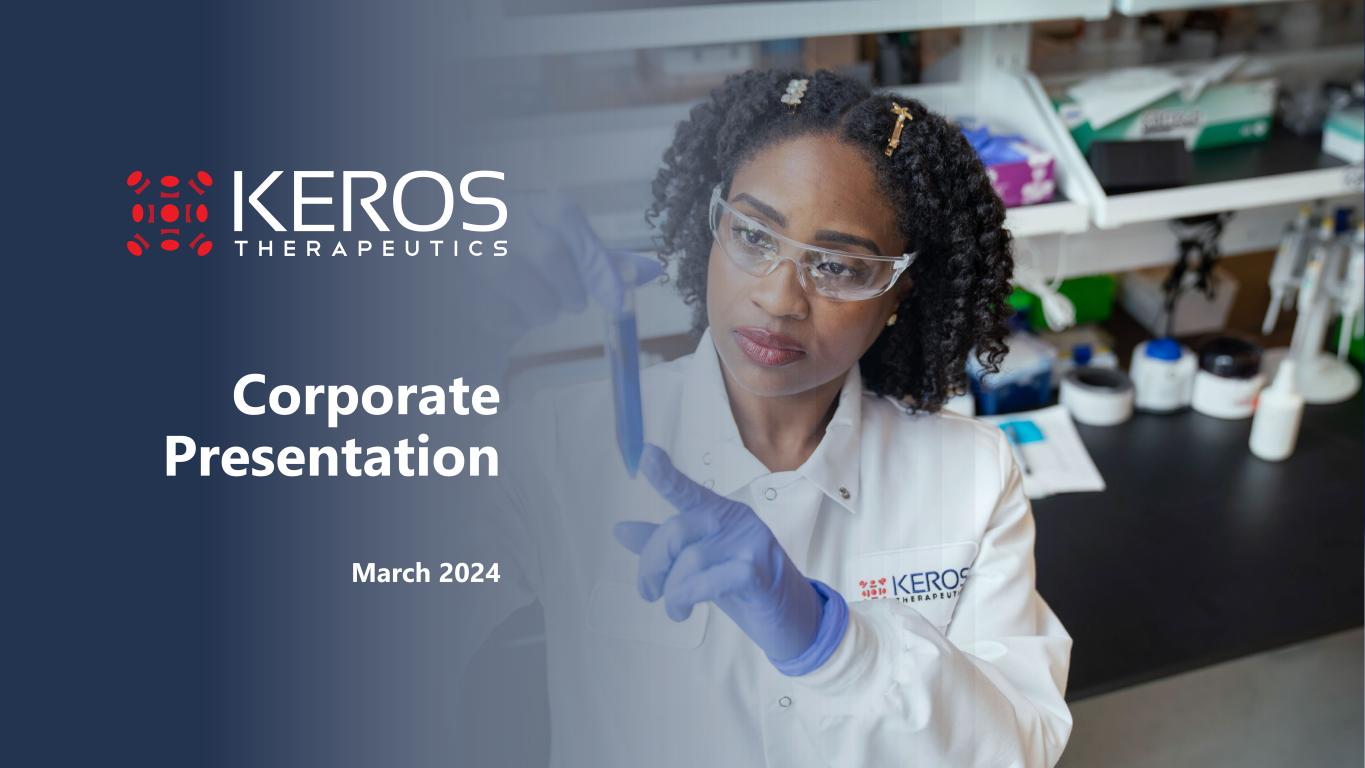
March 2024 Corporate Presentation
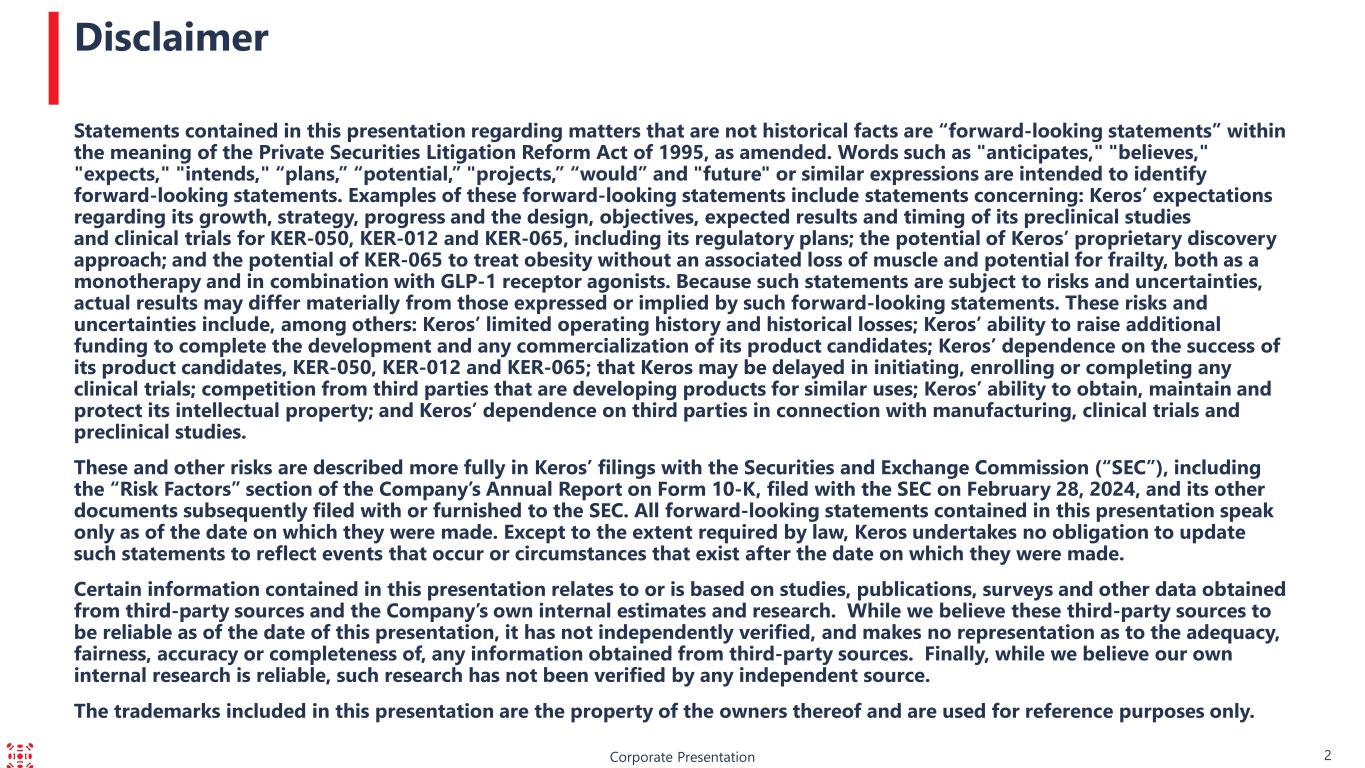
Corporate Presentation Statements contained in this presentation regarding matters that are not historical facts are “forward-looking statements” within the meaning of the Private Securities Litigation Reform Act of 1995, as amended. Words such as "anticipates," "believes," "expects," "intends," “plans,” “potential,” "projects,” “would” and "future" or similar expressions are intended to identify forward-looking statements. Examples of these forward-looking statements include statements concerning: Keros’ expectations regarding its growth, strategy, progress and the design, objectives, expected results and timing of its preclinical studies and clinical trials for KER-050, KER-012 and KER-065, including its regulatory plans; the potential of Keros’ proprietary discovery approach; and the potential of KER-065 to treat obesity without an associated loss of muscle and potential for frailty, both as a monotherapy and in combination with GLP-1 receptor agonists. Because such statements are subject to risks and uncertainties, actual results may differ materially from those expressed or implied by such forward-looking statements. These risks and uncertainties include, among others: Keros’ limited operating history and historical losses; Keros’ ability to raise additional funding to complete the development and any commercialization of its product candidates; Keros’ dependence on the success of its product candidates, KER-050, KER-012 and KER-065; that Keros may be delayed in initiating, enrolling or completing any clinical trials; competition from third parties that are developing products for similar uses; Keros’ ability to obtain, maintain and protect its intellectual property; and Keros’ dependence on third parties in connection with manufacturing, clinical trials and preclinical studies. These and other risks are described more fully in Keros’ filings with the Securities and Exchange Commission (“SEC”), including the “Risk Factors” section of the Company’s Annual Report on Form 10-K, filed with the SEC on February 28, 2024, and its other documents subsequently filed with or furnished to the SEC. All forward-looking statements contained in this presentation speak only as of the date on which they were made. Except to the extent required by law, Keros undertakes no obligation to update such statements to reflect events that occur or circumstances that exist after the date on which they were made. Certain information contained in this presentation relates to or is based on studies, publications, surveys and other data obtained from third-party sources and the Company’s own internal estimates and research. While we believe these third-party sources to be reliable as of the date of this presentation, it has not independently verified, and makes no representation as to the adequacy, fairness, accuracy or completeness of, any information obtained from third-party sources. Finally, while we believe our own internal research is reliable, such research has not been verified by any independent source. The trademarks included in this presentation are the property of the owners thereof and are used for reference purposes only. Disclaimer 2
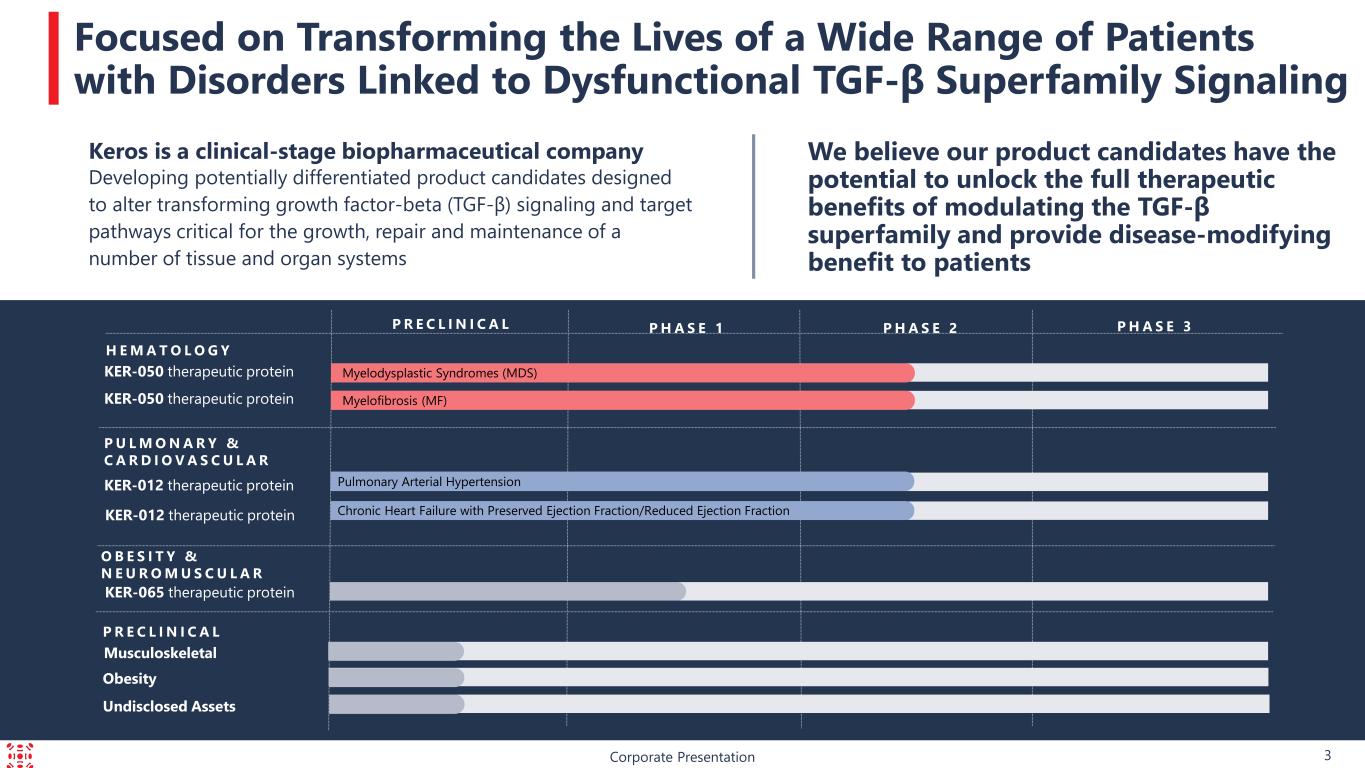
KER-065 therapeutic protein P R E C L I N I C A L Corporate Presentation Focused on Transforming the Lives of a Wide Range of Patients with Disorders Linked to Dysfunctional TGF-β Superfamily Signaling We believe our product candidates have the potential to unlock the full therapeutic benefits of modulating the TGF-β superfamily and provide disease-modifying benefit to patients P H A S E 3P R E C L I N I C A L P H A S E 1 P H A S E 2 KER-050 therapeutic protein KER-050 therapeutic protein H E M A T O L O G Y KER-012 therapeutic protein P U L M O N A R Y & C A R D I O V A S C U L A R Myelodysplastic Syndromes (MDS) Myelofibrosis (MF) Pulmonary Arterial Hypertension Musculoskeletal 4KER-012 therapeutic protein O B E S I T Y & N E U R O M U S C U L A R Chronic Heart Failure with Preserved Ejection Fraction/Reduced Ejection Fraction Keros is a clinical-stage biopharmaceutical company Developing potentially differentiated product candidates designed to alter transforming growth factor-beta (TGF-β) signaling and target pathways critical for the growth, repair and maintenance of a number of tissue and organ systems Undisclosed Assets Obesity 3
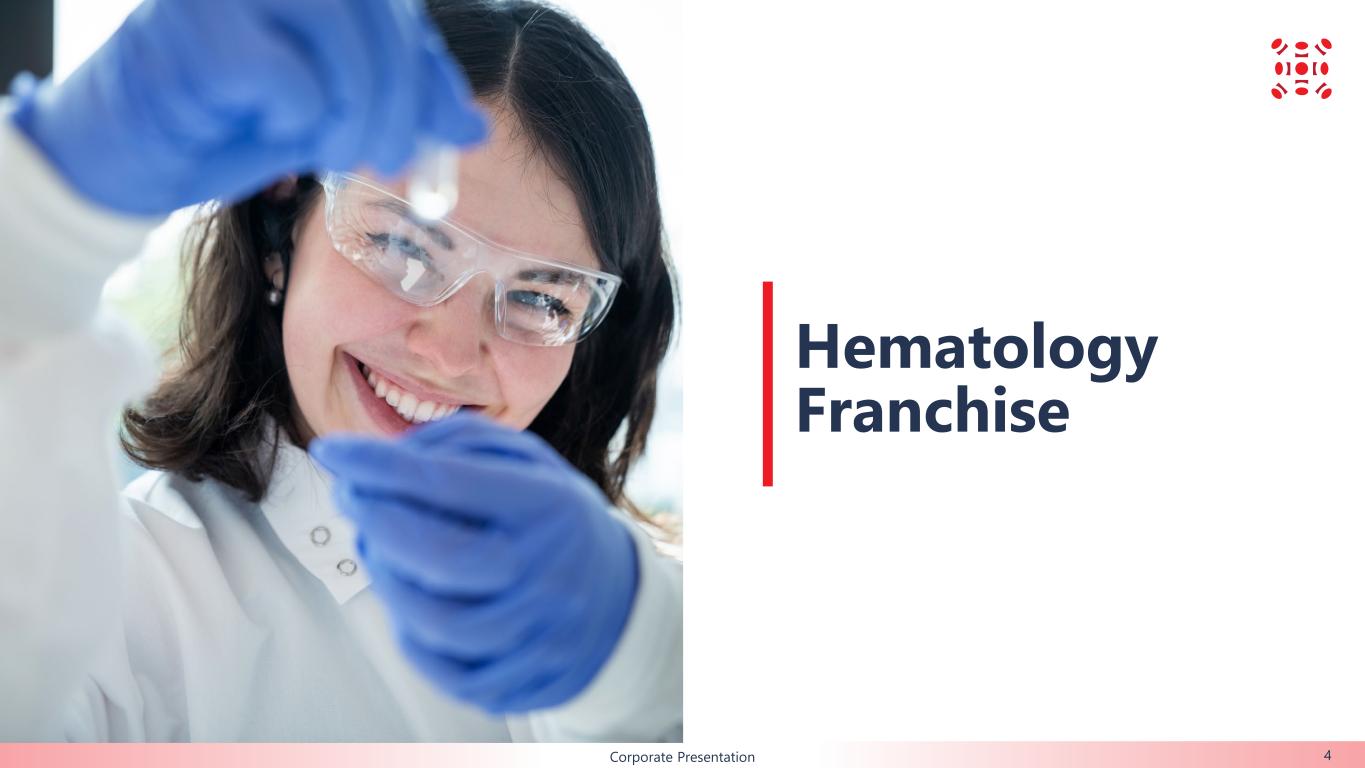
B Hematology Franchise Corporate Presentation 4
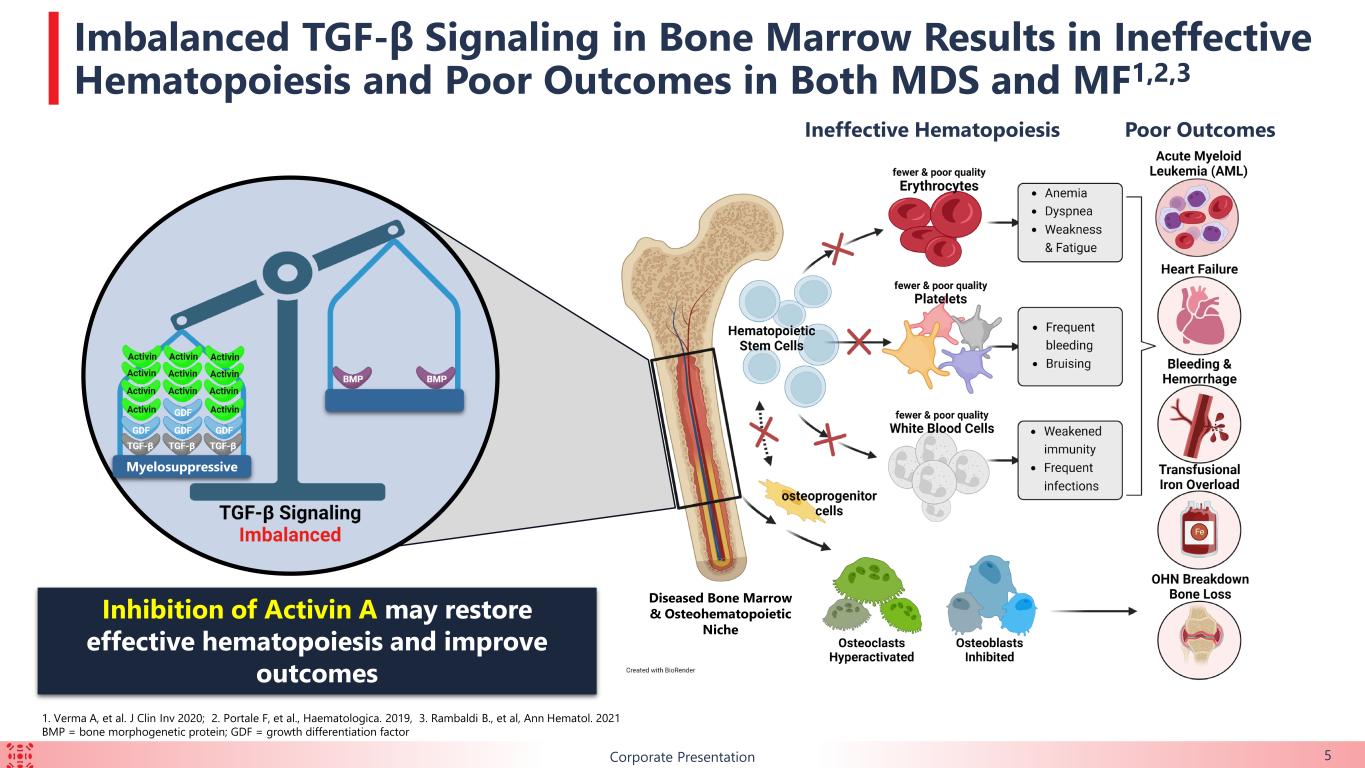
B Imbalanced TGF-β Signaling in Bone Marrow Results in Ineffective Hematopoiesis and Poor Outcomes in Both MDS and MF1,2,3 Inhibition of Activin A may restore effective hematopoiesis and improve outcomes Poor Outcomes 1. Verma A, et al. J Clin Inv 2020; 2. Portale F, et al., Haematologica. 2019, 3. Rambaldi B., et al, Ann Hematol. 2021 BMP = bone morphogenetic protein; GDF = growth differentiation factor Myelosuppressive Ineffective Hematopoiesis Diseased Bone Marrow & Osteohematopoietic Niche Corporate Presentation 5
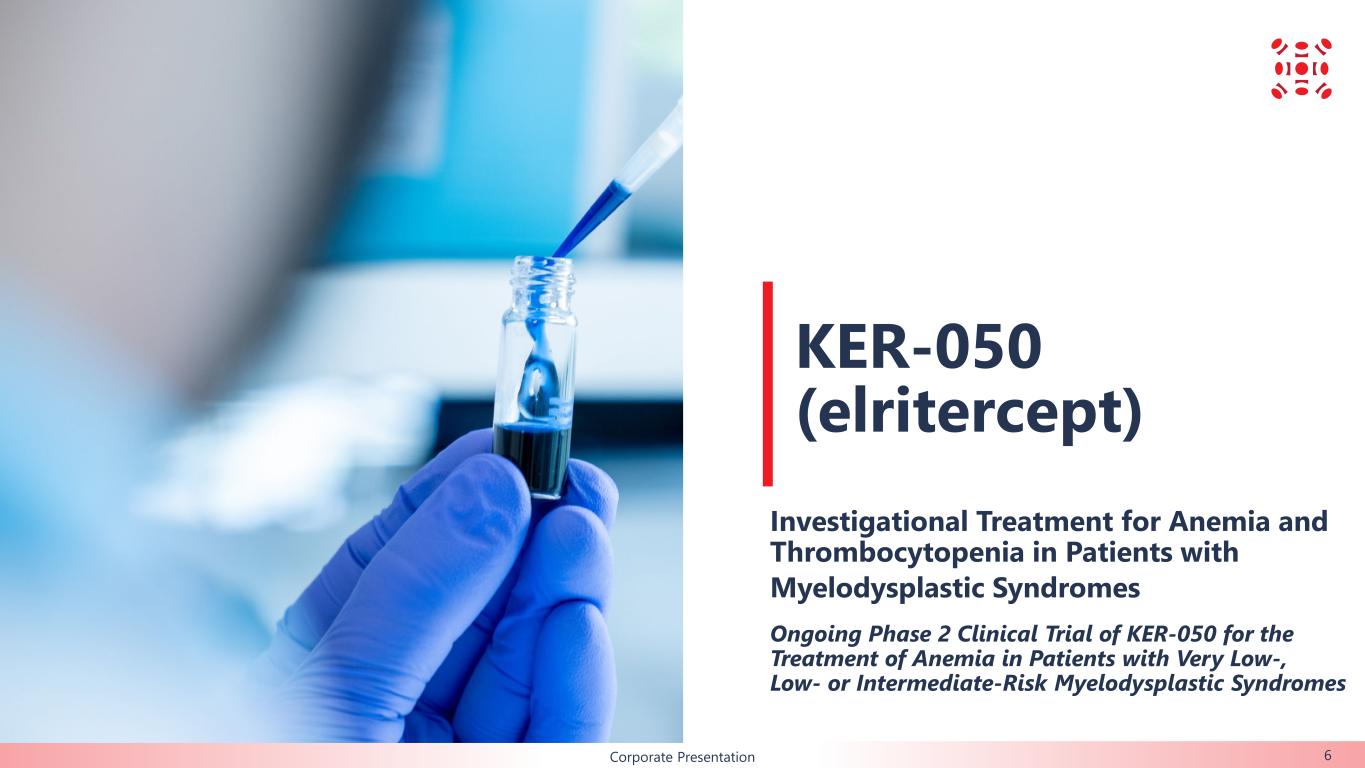
B KER-050 (elritercept) Investigational Treatment for Anemia and Thrombocytopenia in Patients with Myelodysplastic Syndromes Ongoing Phase 2 Clinical Trial of KER-050 for the Treatment of Anemia in Patients with Very Low-, Low- or Intermediate-Risk Myelodysplastic Syndromes Corporate Presentation 6
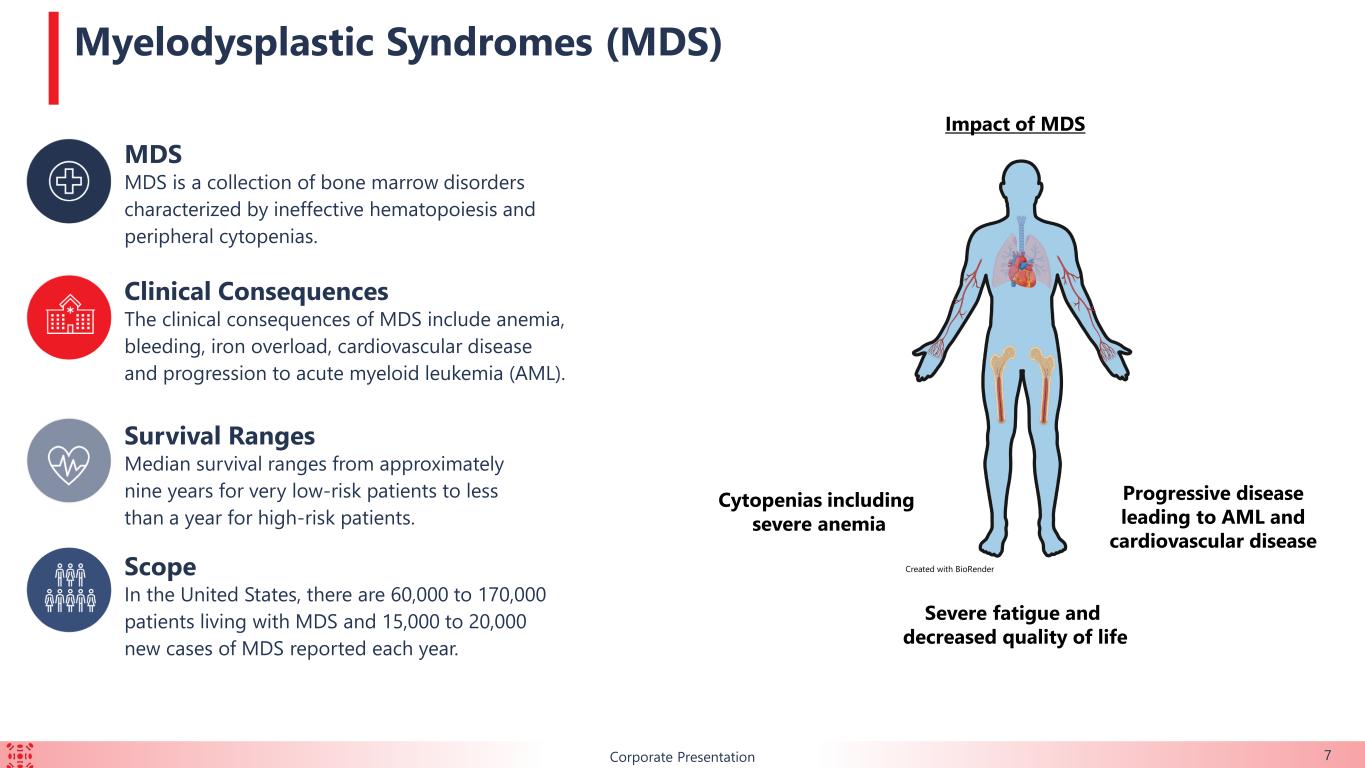
BCorporate Presentation MDS MDS is a collection of bone marrow disorders characterized by ineffective hematopoiesis and peripheral cytopenias. Clinical Consequences The clinical consequences of MDS include anemia, bleeding, iron overload, cardiovascular disease and progression to acute myeloid leukemia (AML). Survival Ranges Median survival ranges from approximately nine years for very low-risk patients to less than a year for high-risk patients. Scope In the United States, there are 60,000 to 170,000 patients living with MDS and 15,000 to 20,000 new cases of MDS reported each year. Myelodysplastic Syndromes (MDS) Progressive disease leading to AML and cardiovascular disease Cytopenias including severe anemia Severe fatigue and decreased quality of life Impact of MDS Created with BioRender 7
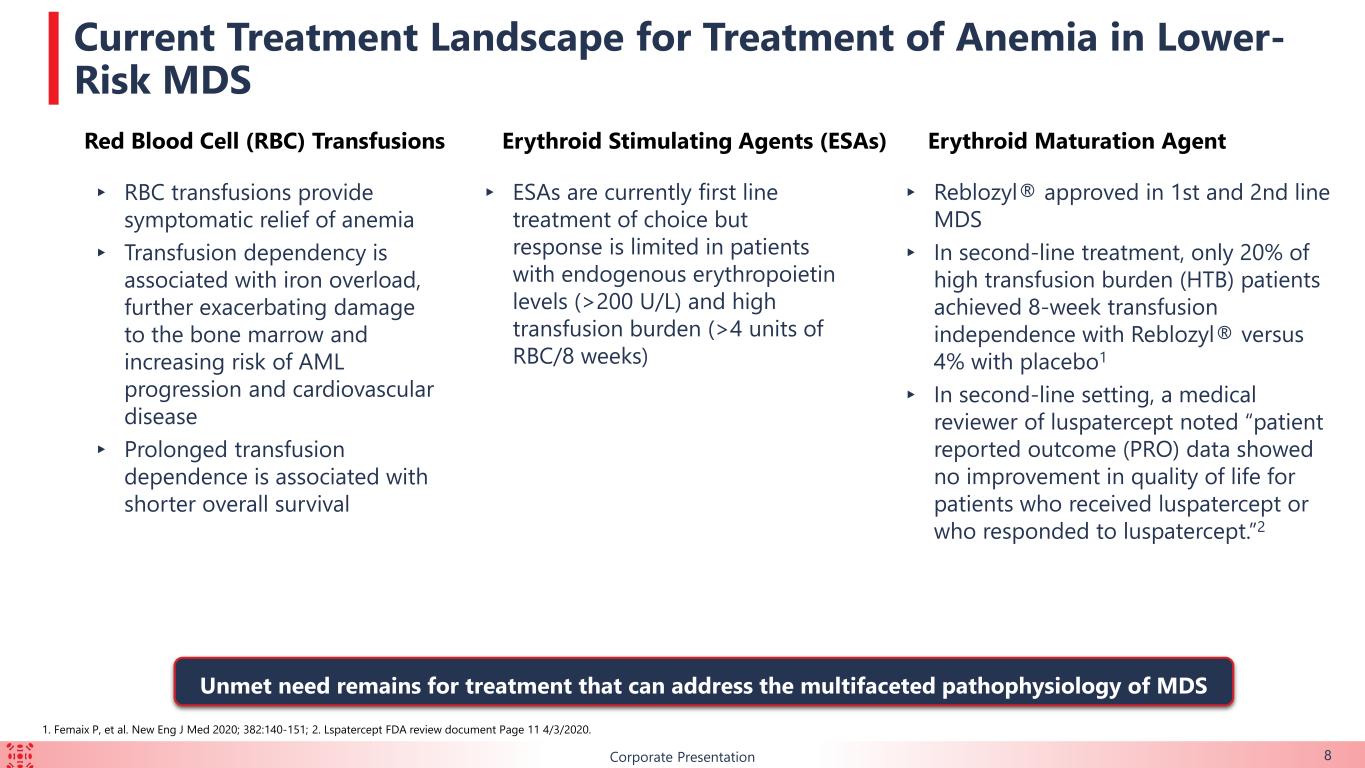
Corporate Presentation Current Treatment Landscape for Treatment of Anemia in Lower- Risk MDS 1. Femaix P, et al. New Eng J Med 2020; 382:140-151; 2. Lspatercept FDA review document Page 11 4/3/2020. Red Blood Cell (RBC) Transfusions ▸ ESAs are currently first line treatment of choice but response is limited in patients with endogenous erythropoietin levels (>200 U/L) and high transfusion burden (>4 units of RBC/8 weeks) Erythroid Maturation Agent Erythroid Stimulating Agents (ESAs) ▸ RBC transfusions provide symptomatic relief of anemia ▸ Transfusion dependency is associated with iron overload, further exacerbating damage to the bone marrow and increasing risk of AML progression and cardiovascular disease ▸ Prolonged transfusion dependence is associated with shorter overall survival ▸ Reblozyl® approved in 1st and 2nd line MDS ▸ In second-line treatment, only 20% of high transfusion burden (HTB) patients achieved 8-week transfusion independence with Reblozyl® versus 4% with placebo1 ▸ In second-line setting, a medical reviewer of luspatercept noted “patient reported outcome (PRO) data showed no improvement in quality of life for patients who received luspatercept or who responded to luspatercept.”2 Unmet need remains for treatment that can address the multifaceted pathophysiology of MDS 8
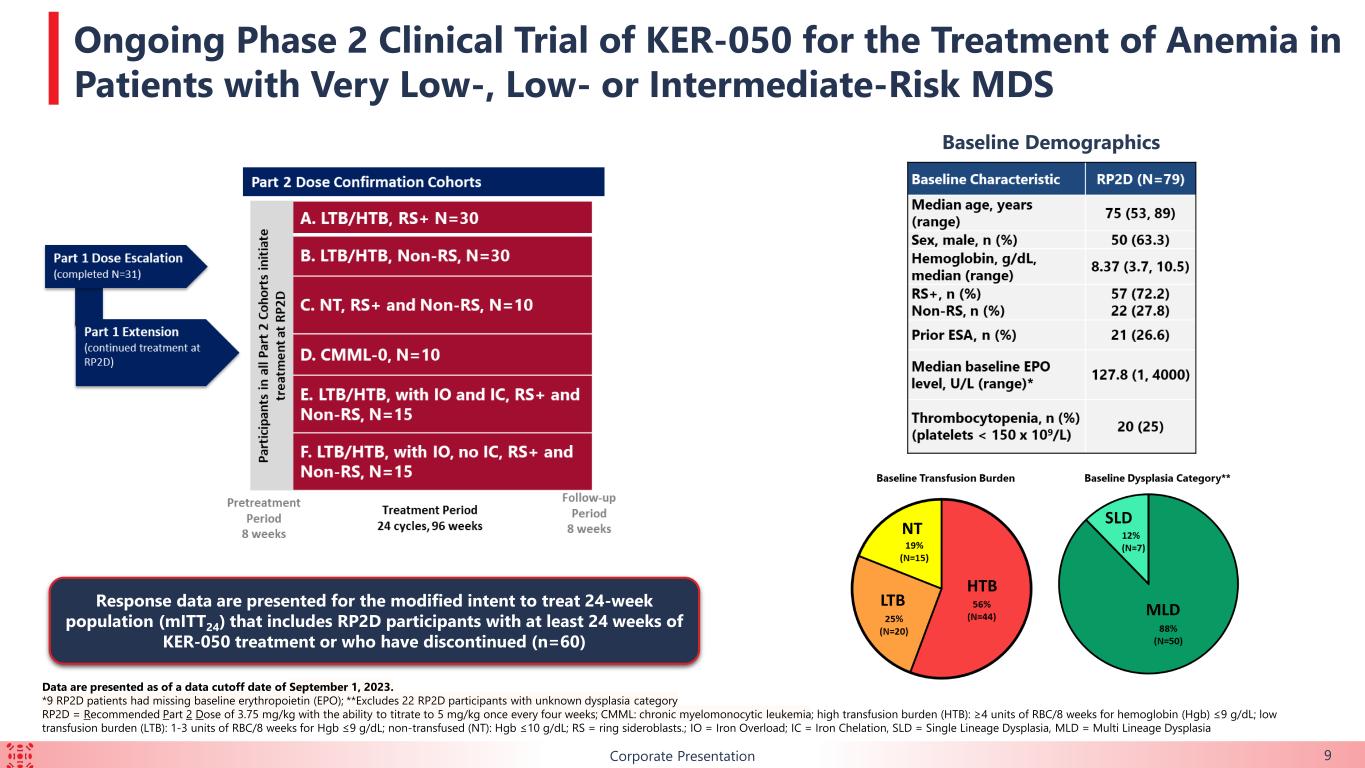
BCorporate Presentation Data are presented as of a data cutoff date of September 1, 2023. *9 RP2D patients had missing baseline erythropoietin (EPO); **Excludes 22 RP2D participants with unknown dysplasia category RP2D = Recommended Part 2 Dose of 3.75 mg/kg with the ability to titrate to 5 mg/kg once every four weeks; CMML: chronic myelomonocytic leukemia; high transfusion burden (HTB): ≥4 units of RBC/8 weeks for hemoglobin (Hgb) ≤9 g/dL; low transfusion burden (LTB): 1-3 units of RBC/8 weeks for Hgb ≤9 g/dL; non-transfused (NT): Hgb ≤10 g/dL; RS = ring sideroblasts.; IO = Iron Overload; IC = Iron Chelation, SLD = Single Lineage Dysplasia, MLD = Multi Lineage Dysplasia Ongoing Phase 2 Clinical Trial of KER-050 for the Treatment of Anemia in Patients with Very Low-, Low- or Intermediate-Risk MDS Response data are presented for the modified intent to treat 24-week population (mITT24) that includes RP2D participants with at least 24 weeks of KER-050 treatment or who have discontinued (n=60) Baseline Demographics 9
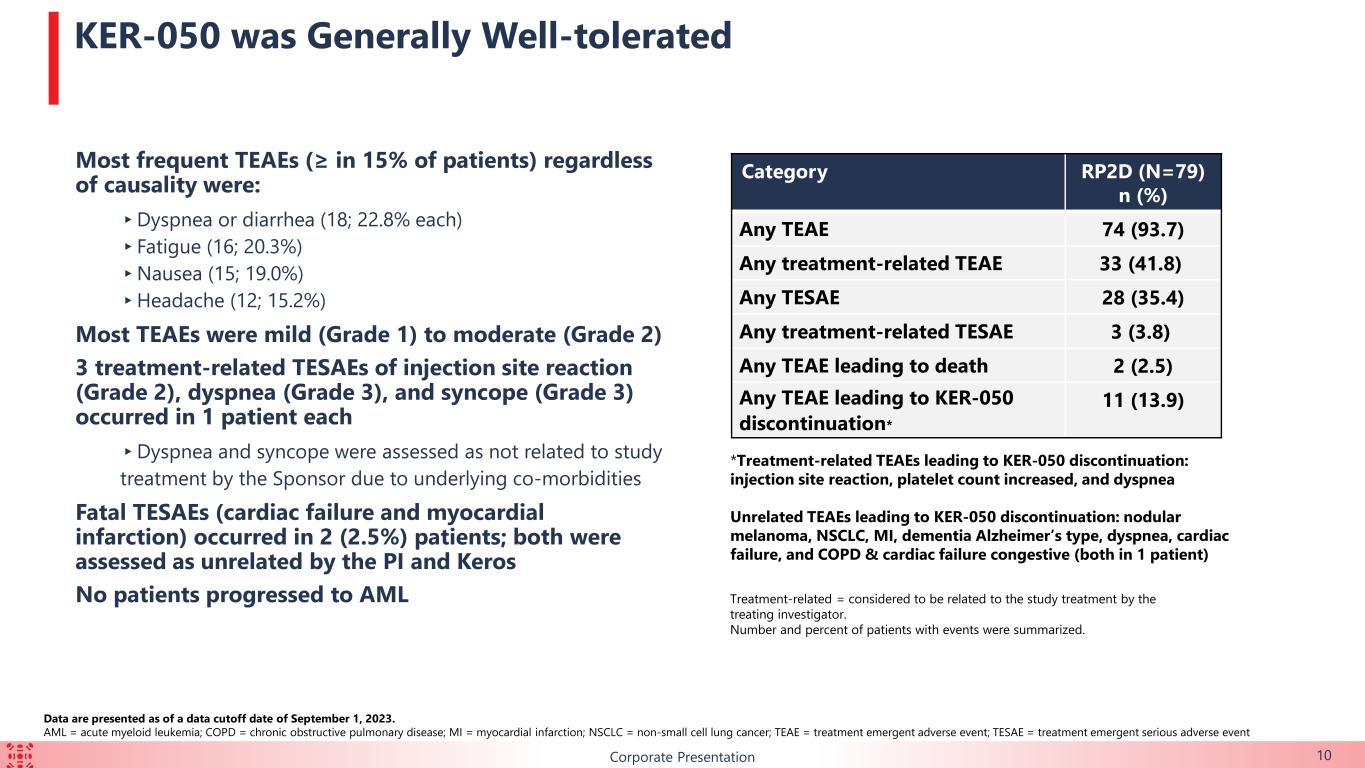
BCorporate Presentation KER-050 was Generally Well-tolerated Most frequent TEAEs (≥ in 15% of patients) regardless of causality were: ▸Dyspnea or diarrhea (18; 22.8% each) ▸Fatigue (16; 20.3%) ▸Nausea (15; 19.0%) ▸Headache (12; 15.2%) Most TEAEs were mild (Grade 1) to moderate (Grade 2) 3 treatment-related TESAEs of injection site reaction (Grade 2), dyspnea (Grade 3), and syncope (Grade 3) occurred in 1 patient each ▸Dyspnea and syncope were assessed as not related to study treatment by the Sponsor due to underlying co-morbidities Fatal TESAEs (cardiac failure and myocardial infarction) occurred in 2 (2.5%) patients; both were assessed as unrelated by the PI and Keros No patients progressed to AML Category RP2D (N=79) n (%) Any TEAE 74 (93.7) Any treatment-related TEAE 33 (41.8) Any TESAE 28 (35.4) Any treatment-related TESAE 3 (3.8) Any TEAE leading to death 2 (2.5) Any TEAE leading to KER-050 discontinuation* 11 (13.9) Treatment-related = considered to be related to the study treatment by the treating investigator. Number and percent of patients with events were summarized. *Treatment-related TEAEs leading to KER-050 discontinuation: injection site reaction, platelet count increased, and dyspnea Unrelated TEAEs leading to KER-050 discontinuation: nodular melanoma, NSCLC, MI, dementia Alzheimer’s type, dyspnea, cardiac failure, and COPD & cardiac failure congestive (both in 1 patient) Data are presented as of a data cutoff date of September 1, 2023. AML = acute myeloid leukemia; COPD = chronic obstructive pulmonary disease; MI = myocardial infarction; NSCLC = non-small cell lung cancer; TEAE = treatment emergent adverse event; TESAE = treatment emergent serious adverse event 10
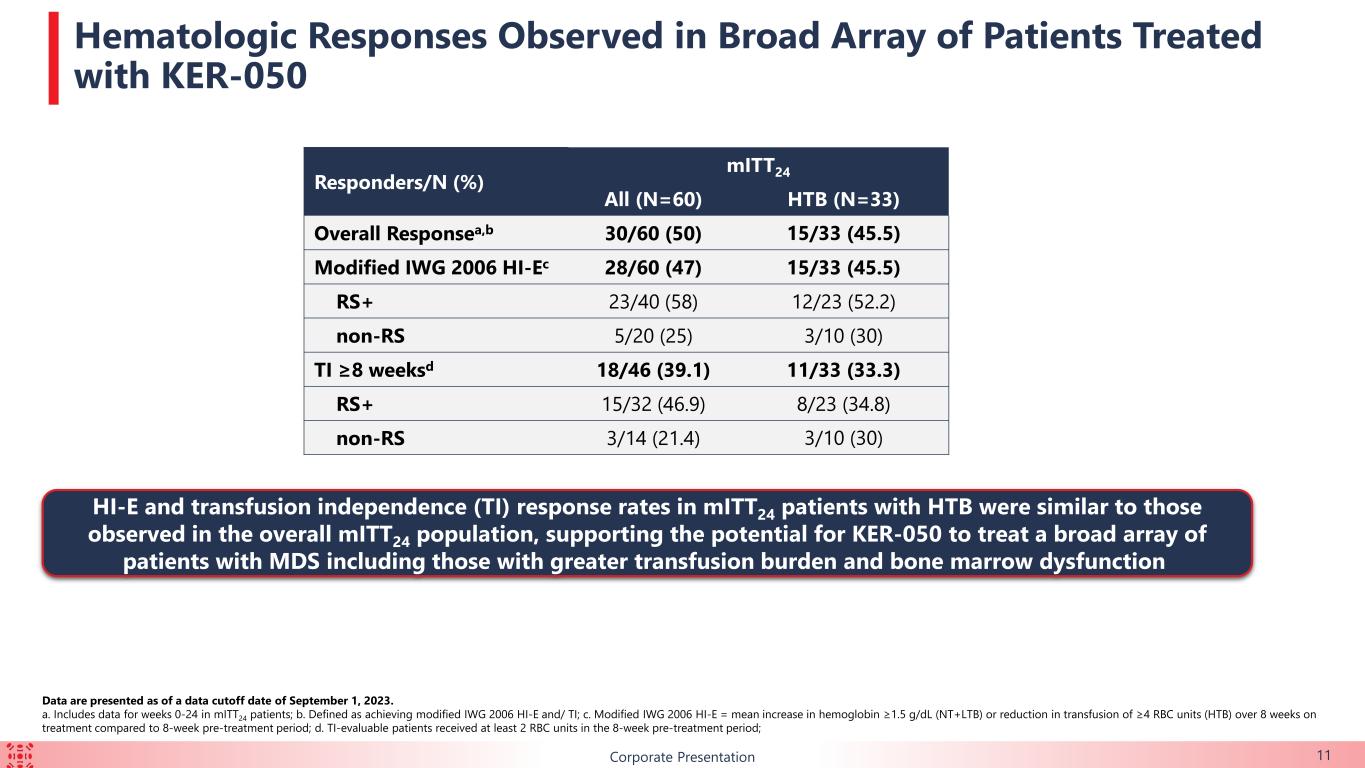
BCorporate Presentation Hematologic Responses Observed in Broad Array of Patients Treated with KER-050 Responders/N (%) mITT24 All (N=60) HTB (N=33) Overall Responsea,b 30/60 (50) 15/33 (45.5) Modified IWG 2006 HI-Ec 28/60 (47) 15/33 (45.5) RS+ 23/40 (58) 12/23 (52.2) non-RS 5/20 (25) 3/10 (30) TI ≥8 weeksd 18/46 (39.1) 11/33 (33.3) RS+ 15/32 (46.9) 8/23 (34.8) non-RS 3/14 (21.4) 3/10 (30) Data are presented as of a data cutoff date of September 1, 2023. a. Includes data for weeks 0-24 in mITT24 patients; b. Defined as achieving modified IWG 2006 HI-E and/ TI; c. Modified IWG 2006 HI-E = mean increase in hemoglobin ≥1.5 g/dL (NT+LTB) or reduction in transfusion of ≥4 RBC units (HTB) over 8 weeks on treatment compared to 8-week pre-treatment period; d. TI-evaluable patients received at least 2 RBC units in the 8-week pre-treatment period; HI-E and transfusion independence (TI) response rates in mITT24 patients with HTB were similar to those observed in the overall mITT24 population, supporting the potential for KER-050 to treat a broad array of patients with MDS including those with greater transfusion burden and bone marrow dysfunction 11
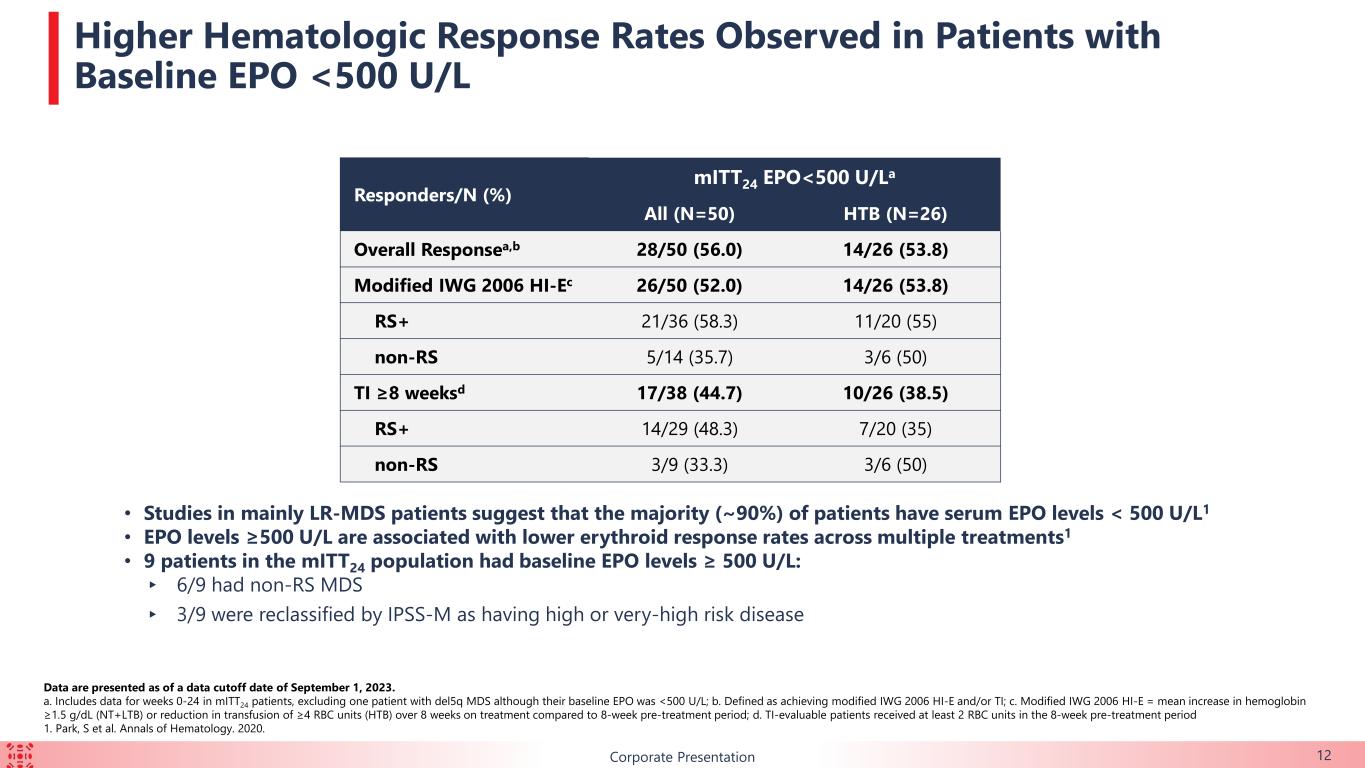
BCorporate Presentation Higher Hematologic Response Rates Observed in Patients with Baseline EPO <500 U/L • Studies in mainly LR-MDS patients suggest that the majority (~90%) of patients have serum EPO levels < 500 U/L1 • EPO levels ≥500 U/L are associated with lower erythroid response rates across multiple treatments1 • 9 patients in the mITT24 population had baseline EPO levels ≥ 500 U/L: ▸ 6/9 had non-RS MDS ▸ 3/9 were reclassified by IPSS-M as having high or very-high risk disease Data are presented as of a data cutoff date of September 1, 2023. a. Includes data for weeks 0-24 in mITT24 patients, excluding one patient with del5q MDS although their baseline EPO was <500 U/L; b. Defined as achieving modified IWG 2006 HI-E and/or TI; c. Modified IWG 2006 HI-E = mean increase in hemoglobin ≥1.5 g/dL (NT+LTB) or reduction in transfusion of ≥4 RBC units (HTB) over 8 weeks on treatment compared to 8-week pre-treatment period; d. TI-evaluable patients received at least 2 RBC units in the 8-week pre-treatment period 1. Park, S et al. Annals of Hematology. 2020. Responders/N (%) mITT24 EPO<500 U/La All (N=50) HTB (N=26) Overall Responsea,b 28/50 (56.0) 14/26 (53.8) Modified IWG 2006 HI-Ec 26/50 (52.0) 14/26 (53.8) RS+ 21/36 (58.3) 11/20 (55) non-RS 5/14 (35.7) 3/6 (50) TI ≥8 weeksd 17/38 (44.7) 10/26 (38.5) RS+ 14/29 (48.3) 7/20 (35) non-RS 3/9 (33.3) 3/6 (50) 12
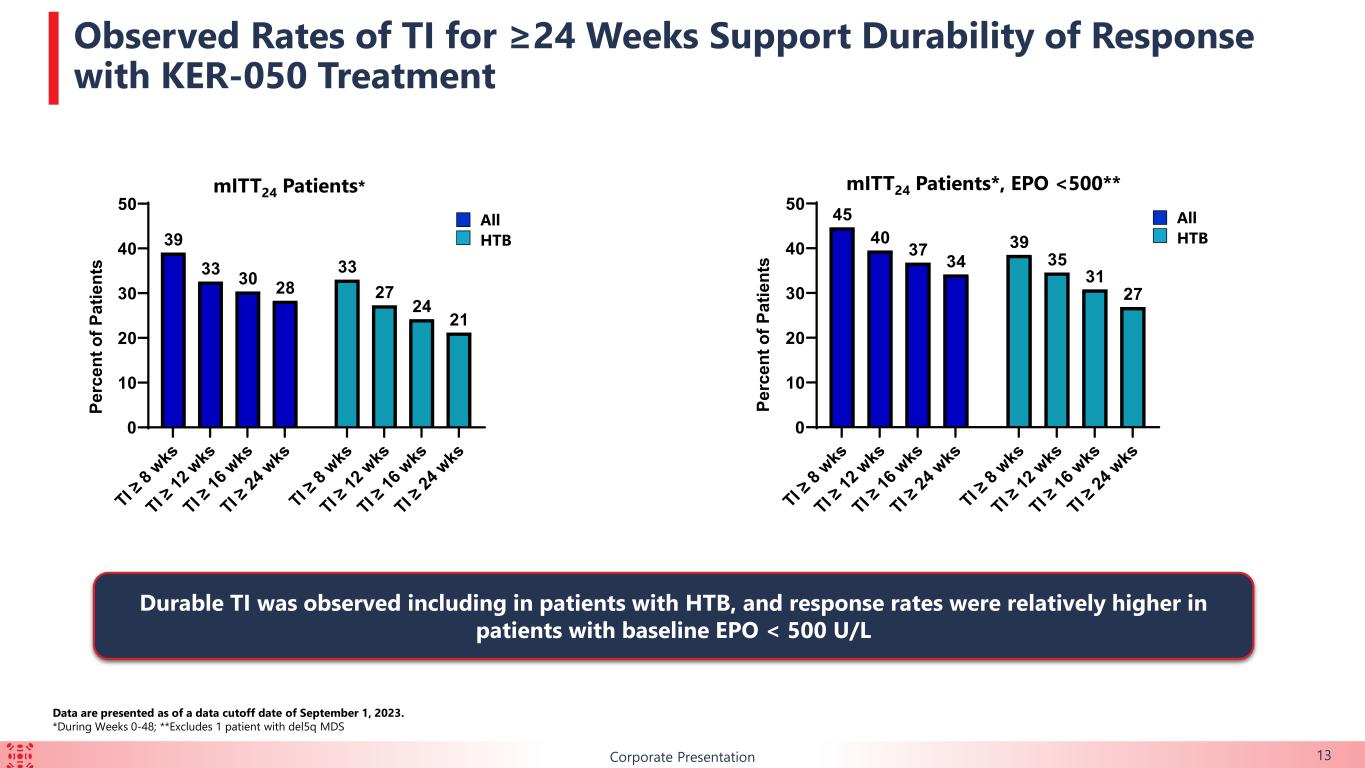
B TI ≥ 8 wks TI ≥ 12 w ks TI ≥ 16 w ks TI ≥ 24 w ks TI ≥ 8 wks TI ≥ 12 w ks TI ≥ 16 w ks TI ≥ 24 w ks 0 10 20 30 40 50 39 35 31 27 45 40 37 34 Pe rc en t o f P ar tic ip an ts Corporate Presentation Observed Rates of TI for ≥24 Weeks Support Durability of Response with KER-050 Treatment TI ≥ 8 wks TI ≥ 12 w ks TI ≥ 16 w ks TI ≥ 24 w ks TI ≥ 8 wks TI ≥ 12 w ks TI ≥ 16 w ks TI ≥ 24 w ks 0 10 20 30 40 50 33 27 24 21 39 33 30 28 Pe rc en t o f P ar tic ip an ts All HTB mITT24 Patients* mITT24 Patients*, EPO <500** Data are presented as of a data cutoff date of September 1, 2023. *During Weeks 0-48; **Excludes 1 patient with del5q MDS Durable TI was observed including in patients with HTB, and response rates were relatively higher in patients with baseline EPO < 500 U/L All HTB Pe rc en t o f P at ie nt s Pe rc en t o f P at ie nt s 13
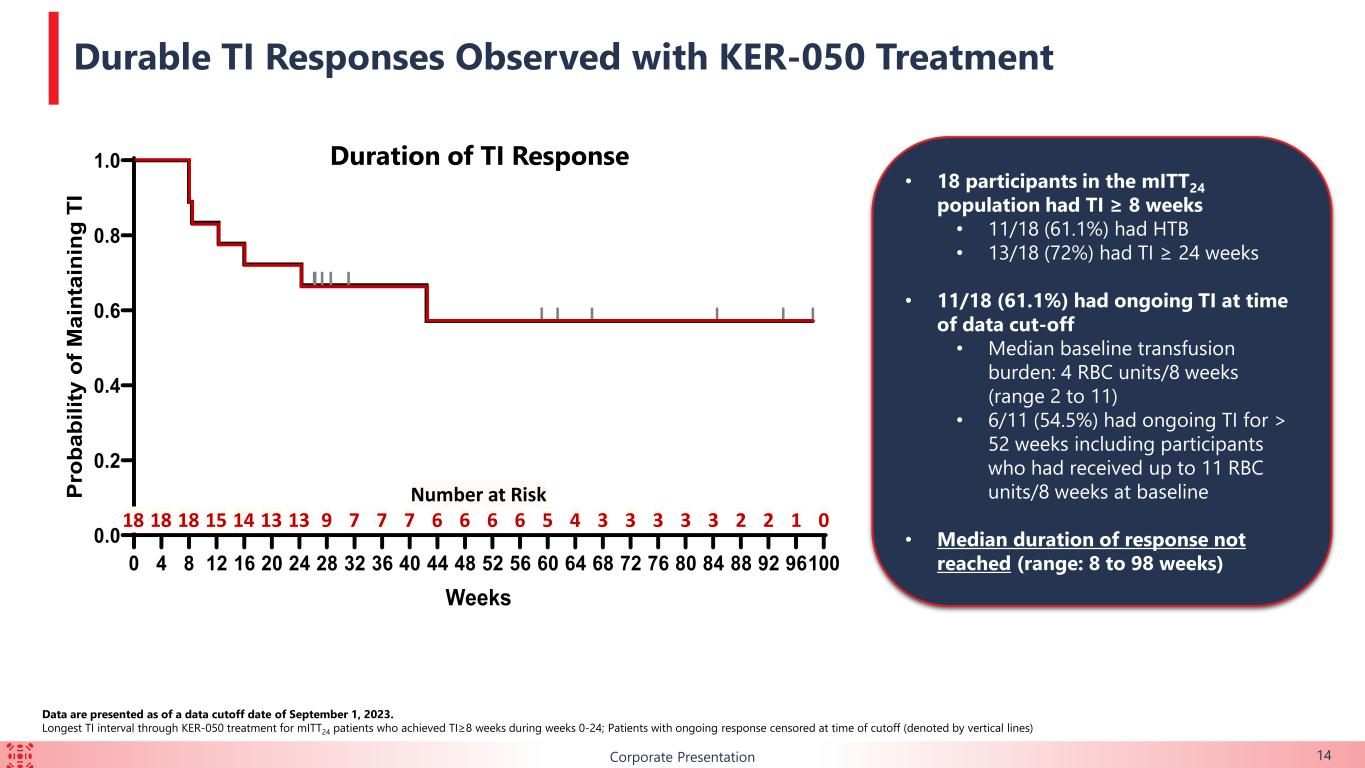
BCorporate Presentation Durable TI Responses Observed with KER-050 Treatment 0 4 8 12 16 20 24 28 32 36 40 44 48 52 56 60 64 68 72 76 80 84 88 92 96100 0.0 0.2 0.4 0.6 0.8 1.0 Weeks P ro ba bi lit y of M ai nt ai ni ng T I Duration of TI Response Number at Risk 18 18 18 15 14 13 13 9 7 7 7 6 6 6 6 5 4 3 3 3 3 3 2 2 1 0 • 18 participants in the mITT24 population had TI ≥ 8 weeks • 11/18 (61.1%) had HTB • 13/18 (72%) had TI ≥ 24 weeks • 11/18 (61.1%) had ongoing TI at time of data cut-off • Median baseline transfusion burden: 4 RBC units/8 weeks (range 2 to 11) • 6/11 (54.5%) had ongoing TI for > 52 weeks including participants who had received up to 11 RBC units/8 weeks at baseline • Median duration of response not reached (range: 8 to 98 weeks) Data are presented as of a data cutoff date of September 1, 2023. Longest TI interval through KER-050 treatment for mITT24 patients who achieved TI≥8 weeks during weeks 0-24; Patients with ongoing response censored at time of cutoff (denoted by vertical lines) 14
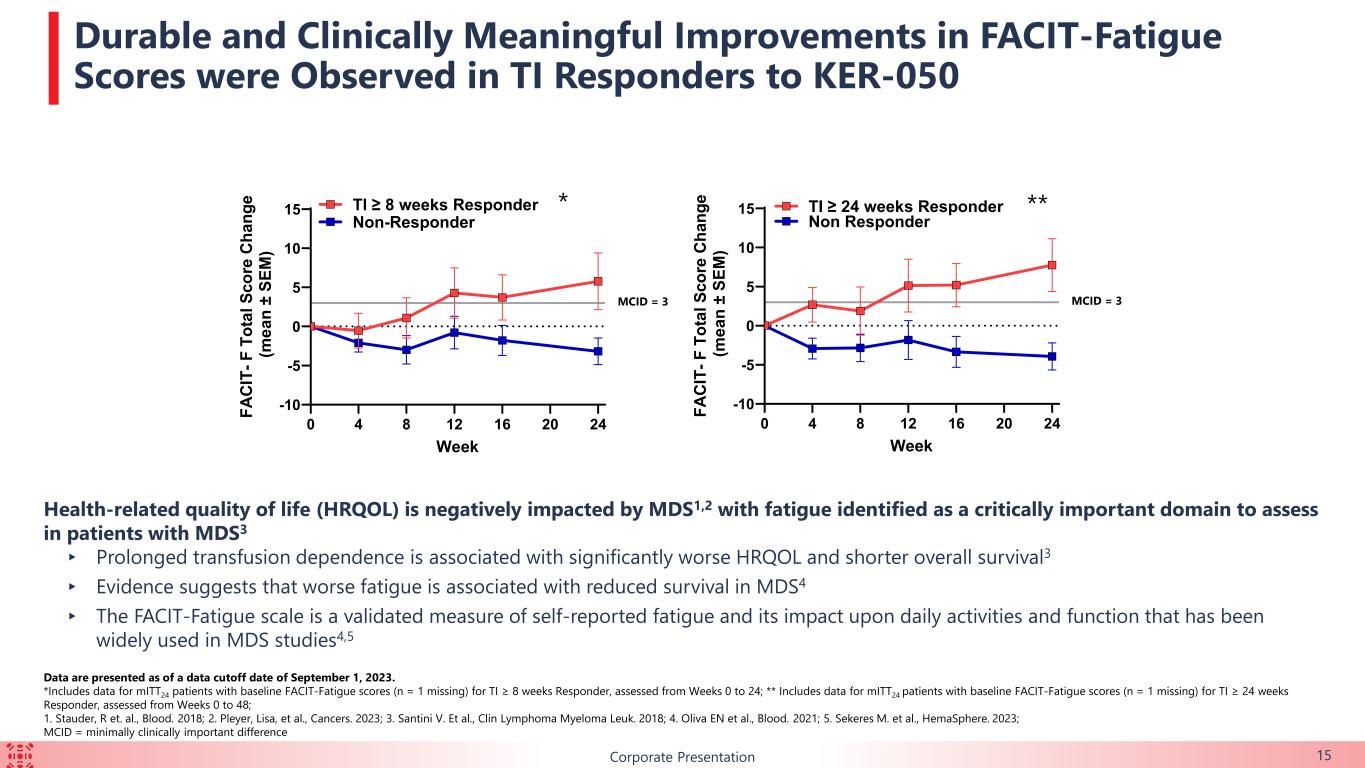
BCorporate Presentation Durable and Clinically Meaningful Improvements in FACIT-Fatigue Scores were Observed in TI Responders to KER-050 0 4 8 12 16 20 24 -10 -5 0 5 10 15 Week FA CI T- F T ot al S co re C ha ng e (m ea n ± SE M ) TI ≥ 24 weeks Responder Non Responder 0 4 8 12 16 20 24 -10 -5 0 5 10 15 Week FA CI T- F T ot al S co re C ha ng e (m ea n ± SE M ) TI ≥ 8 weeks Responder Non-Responder Health-related quality of life (HRQOL) is negatively impacted by MDS1,2 with fatigue identified as a critically important domain to assess in patients with MDS3 ▸ Prolonged transfusion dependence is associated with significantly worse HRQOL and shorter overall survival3 ▸ Evidence suggests that worse fatigue is associated with reduced survival in MDS4 ▸ The FACIT-Fatigue scale is a validated measure of self-reported fatigue and its impact upon daily activities and function that has been widely used in MDS studies4,5 * ** MCID = 3 MCID = 3 Data are presented as of a data cutoff date of September 1, 2023. *Includes data for mITT24 patients with baseline FACIT-Fatigue scores (n = 1 missing) for TI ≥ 8 weeks Responder, assessed from Weeks 0 to 24; ** Includes data for mITT24 patients with baseline FACIT-Fatigue scores (n = 1 missing) for TI ≥ 24 weeks Responder, assessed from Weeks 0 to 48; 1. Stauder, R et. al., Blood. 2018; 2. Pleyer, Lisa, et al., Cancers. 2023; 3. Santini V. Et al., Clin Lymphoma Myeloma Leuk. 2018; 4. Oliva EN et al., Blood. 2021; 5. Sekeres M. et al., HemaSphere. 2023; MCID = minimally clinically important difference 15
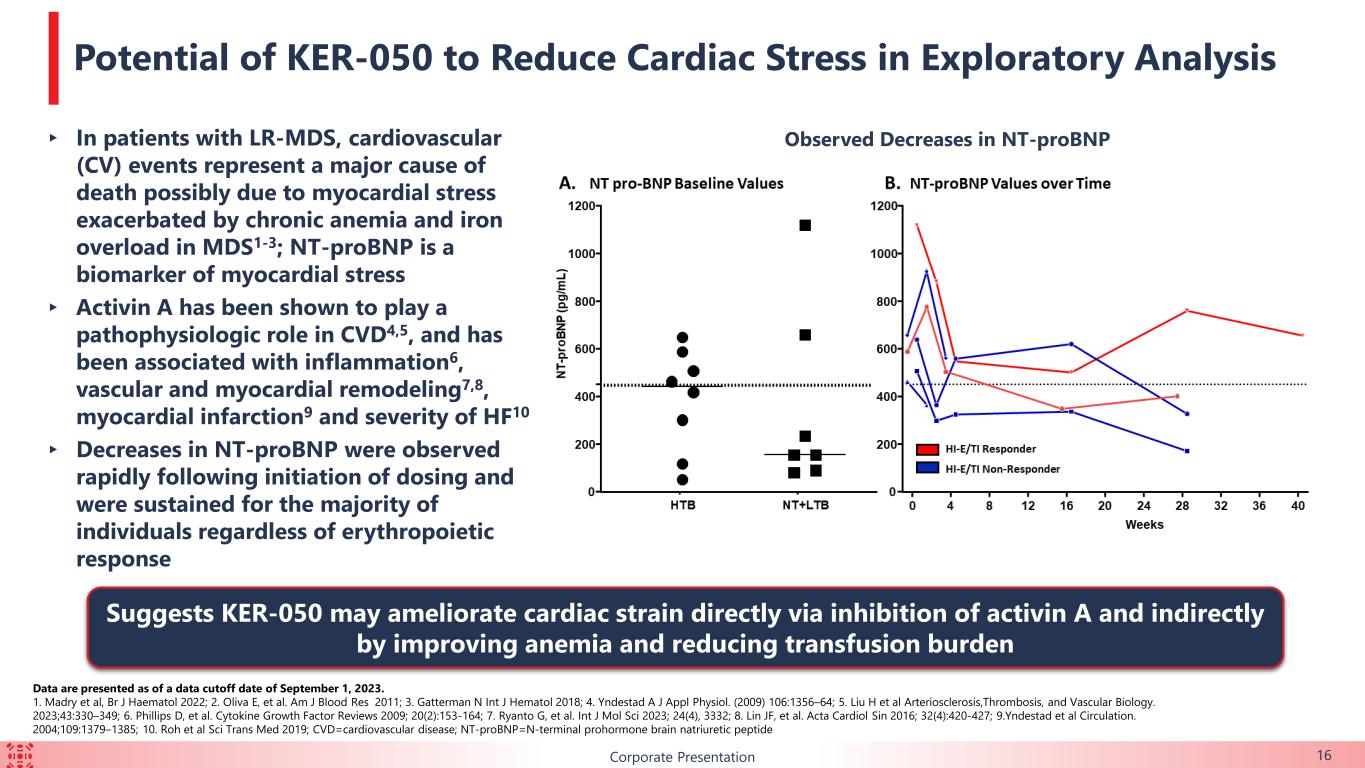
B Data are presented as of a data cutoff date of September 1, 2023. 1. Madry et al, Br J Haematol 2022; 2. Oliva E, et al. Am J Blood Res 2011; 3. Gatterman N Int J Hematol 2018; 4. Yndestad A J Appl Physiol. (2009) 106:1356–64; 5. Liu H et al Arteriosclerosis,Thrombosis, and Vascular Biology. 2023;43:330–349; 6. Phillips D, et al. Cytokine Growth Factor Reviews 2009; 20(2):153-164; 7. Ryanto G, et al. Int J Mol Sci 2023; 24(4), 3332; 8. Lin JF, et al. Acta Cardiol Sin 2016; 32(4):420-427; 9.Yndestad et al Circulation. 2004;109:1379–1385; 10. Roh et al Sci Trans Med 2019; CVD=cardiovascular disease; NT-proBNP=N-terminal prohormone brain natriuretic peptide Corporate Presentation Potential of KER-050 to Reduce Cardiac Stress in Exploratory Analysis ▸ In patients with LR-MDS, cardiovascular (CV) events represent a major cause of death possibly due to myocardial stress exacerbated by chronic anemia and iron overload in MDS1-3; NT-proBNP is a biomarker of myocardial stress ▸ Activin A has been shown to play a pathophysiologic role in CVD4,5, and has been associated with inflammation6, vascular and myocardial remodeling7,8, myocardial infarction9 and severity of HF10 ▸ Decreases in NT-proBNP were observed rapidly following initiation of dosing and were sustained for the majority of individuals regardless of erythropoietic response Observed Decreases in NT-proBNP Suggests KER-050 may ameliorate cardiac strain directly via inhibition of activin A and indirectly by improving anemia and reducing transfusion burden 16
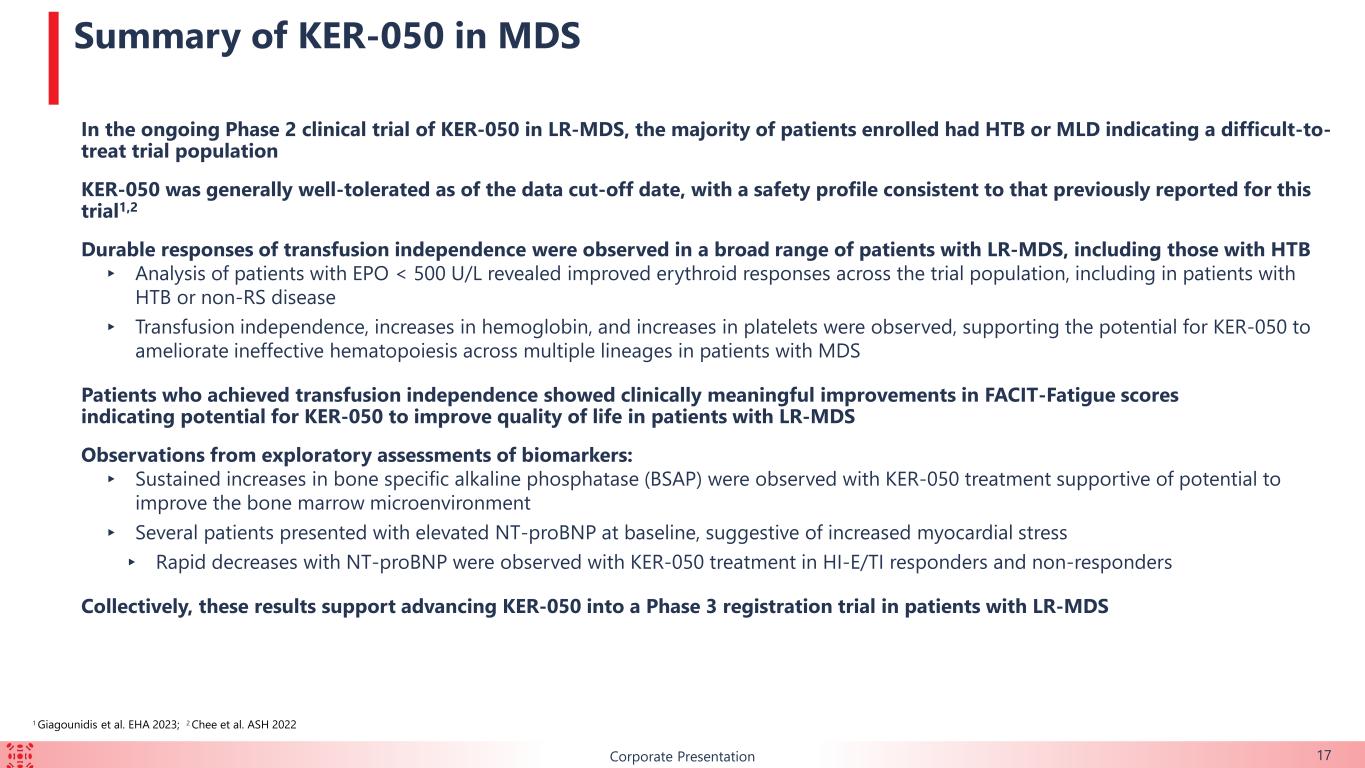
BCorporate Presentation Summary of KER-050 in MDS In the ongoing Phase 2 clinical trial of KER-050 in LR-MDS, the majority of patients enrolled had HTB or MLD indicating a difficult-to- treat trial population KER-050 was generally well-tolerated as of the data cut-off date, with a safety profile consistent to that previously reported for this trial1,2 Durable responses of transfusion independence were observed in a broad range of patients with LR-MDS, including those with HTB ▸ Analysis of patients with EPO < 500 U/L revealed improved erythroid responses across the trial population, including in patients with HTB or non-RS disease ▸ Transfusion independence, increases in hemoglobin, and increases in platelets were observed, supporting the potential for KER-050 to ameliorate ineffective hematopoiesis across multiple lineages in patients with MDS Patients who achieved transfusion independence showed clinically meaningful improvements in FACIT-Fatigue scores indicating potential for KER-050 to improve quality of life in patients with LR-MDS Observations from exploratory assessments of biomarkers: ▸ Sustained increases in bone specific alkaline phosphatase (BSAP) were observed with KER-050 treatment supportive of potential to improve the bone marrow microenvironment ▸ Several patients presented with elevated NT-proBNP at baseline, suggestive of increased myocardial stress ▸ Rapid decreases with NT-proBNP were observed with KER-050 treatment in HI-E/TI responders and non-responders Collectively, these results support advancing KER-050 into a Phase 3 registration trial in patients with LR-MDS 1 Giagounidis et al. EHA 2023; 2 Chee et al. ASH 2022 17
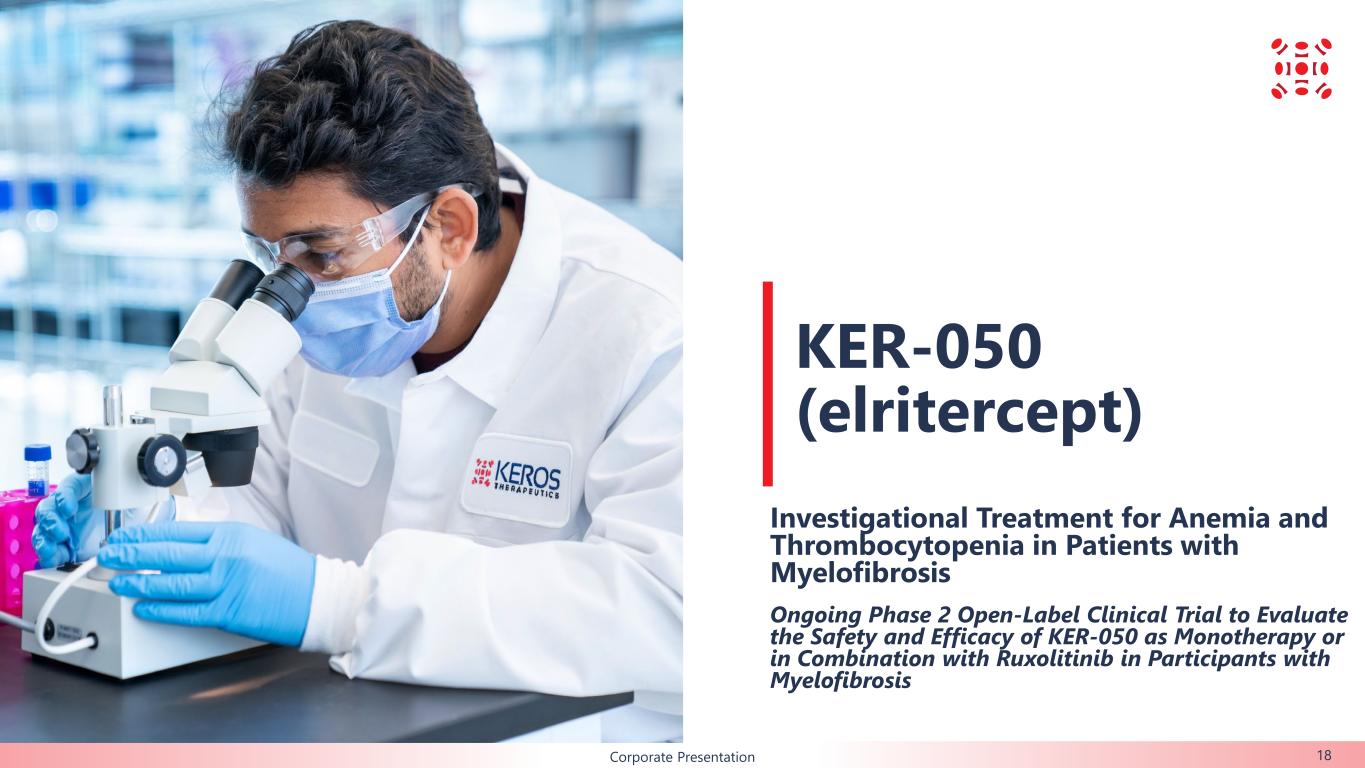
B KER-050 (elritercept) Investigational Treatment for Anemia and Thrombocytopenia in Patients with Myelofibrosis Ongoing Phase 2 Open-Label Clinical Trial to Evaluate the Safety and Efficacy of KER-050 as Monotherapy or in Combination with Ruxolitinib in Participants with Myelofibrosis Corporate Presentation 18
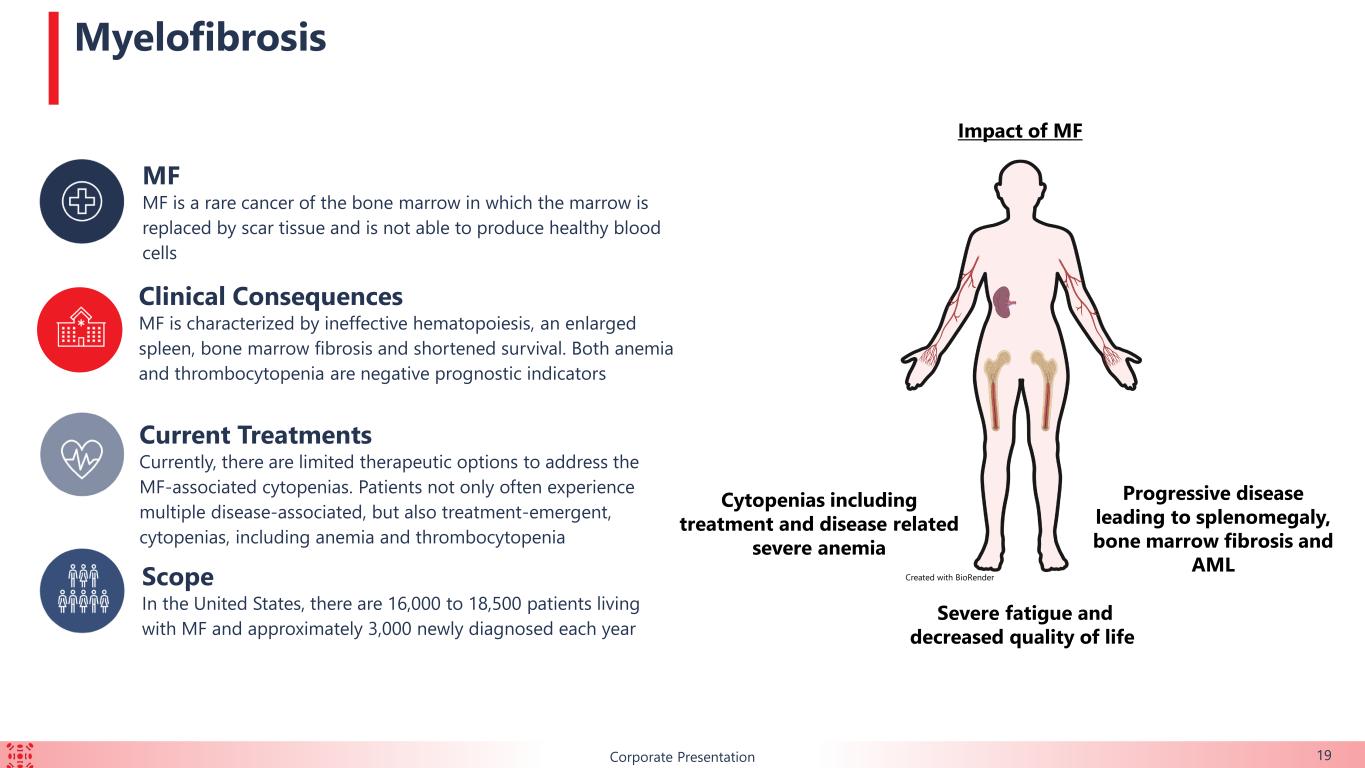
Corporate Presentation Myelofibrosis MF MF is a rare cancer of the bone marrow in which the marrow is replaced by scar tissue and is not able to produce healthy blood cells Current Treatments Currently, there are limited therapeutic options to address the MF-associated cytopenias. Patients not only often experience multiple disease-associated, but also treatment-emergent, cytopenias, including anemia and thrombocytopenia Scope In the United States, there are 16,000 to 18,500 patients living with MF and approximately 3,000 newly diagnosed each year Clinical Consequences MF is characterized by ineffective hematopoiesis, an enlarged spleen, bone marrow fibrosis and shortened survival. Both anemia and thrombocytopenia are negative prognostic indicators Impact of MF Progressive disease leading to splenomegaly, bone marrow fibrosis and AML Cytopenias including treatment and disease related severe anemia Severe fatigue and decreased quality of life Created with BioRender 19
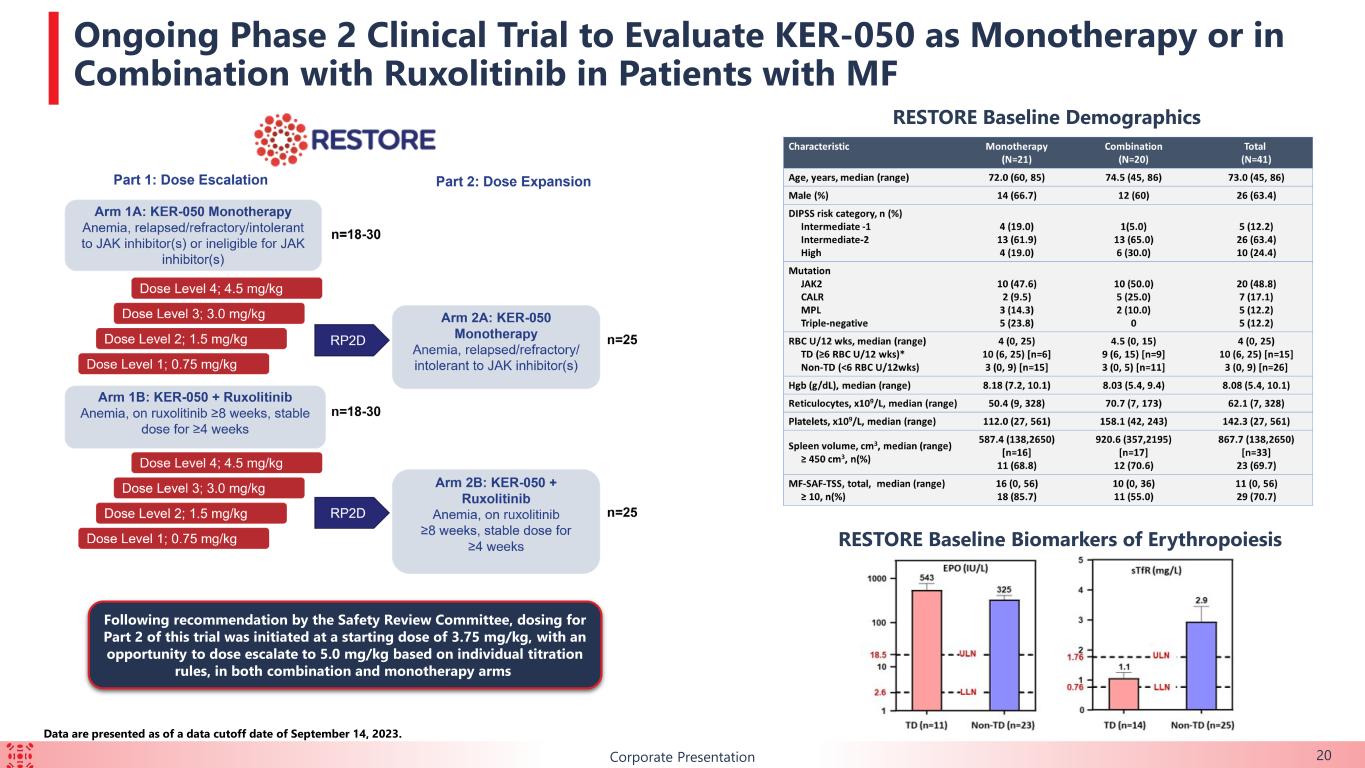
BCorporate Presentation Ongoing Phase 2 Clinical Trial to Evaluate KER-050 as Monotherapy or in Combination with Ruxolitinib in Patients with MF RESTORE Baseline Demographics RESTORE Baseline Biomarkers of Erythropoiesis Data are presented as of a data cutoff date of September 14, 2023. Following recommendation by the Safety Review Committee, dosing for Part 2 of this trial was initiated at a starting dose of 3.75 mg/kg, with an opportunity to dose escalate to 5.0 mg/kg based on individual titration rules, in both combination and monotherapy arms 20
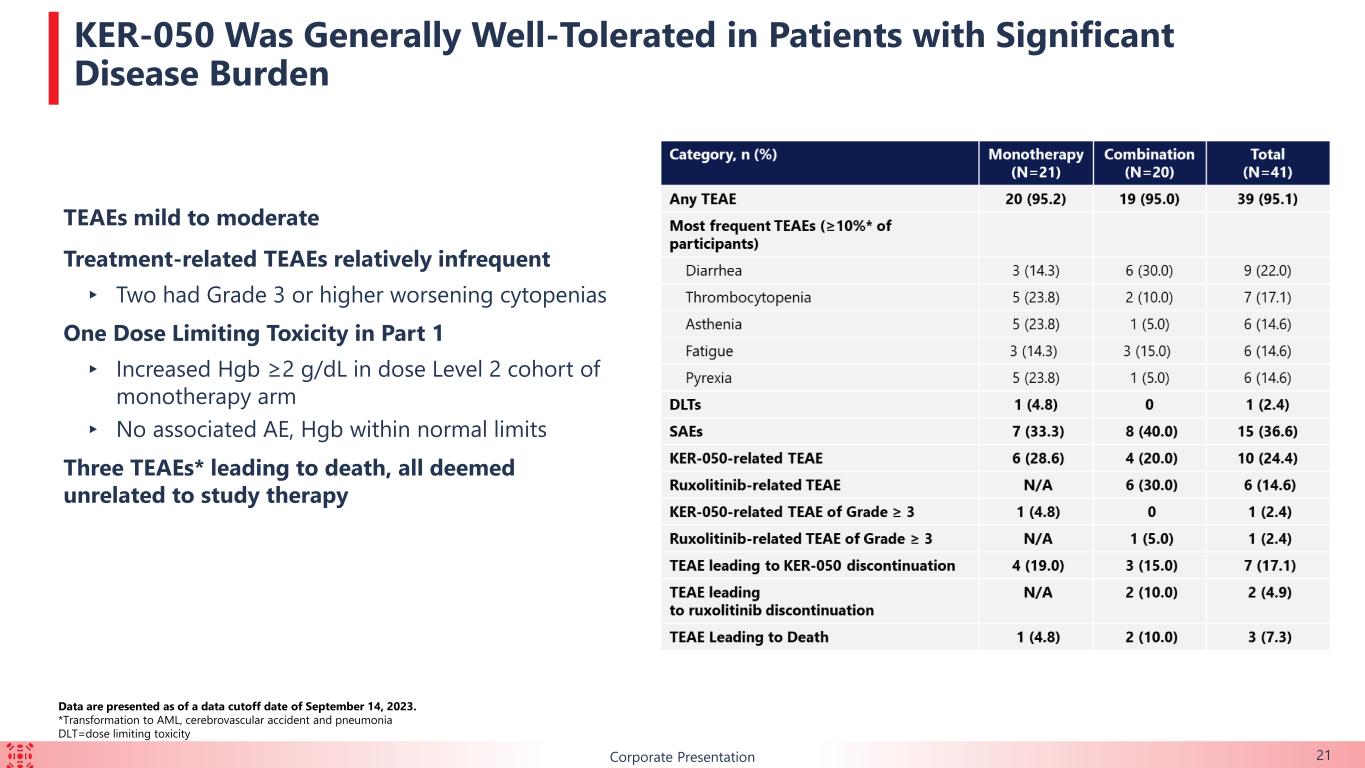
BCorporate Presentation KER-050 Was Generally Well-Tolerated in Patients with Significant Disease Burden TEAEs mild to moderate Treatment-related TEAEs relatively infrequent ▸ Two had Grade 3 or higher worsening cytopenias One Dose Limiting Toxicity in Part 1 ▸ Increased Hgb ≥2 g/dL in dose Level 2 cohort of monotherapy arm ▸ No associated AE, Hgb within normal limits Three TEAEs* leading to death, all deemed unrelated to study therapy Data are presented as of a data cutoff date of September 14, 2023. *Transformation to AML, cerebrovascular accident and pneumonia DLT=dose limiting toxicity 21
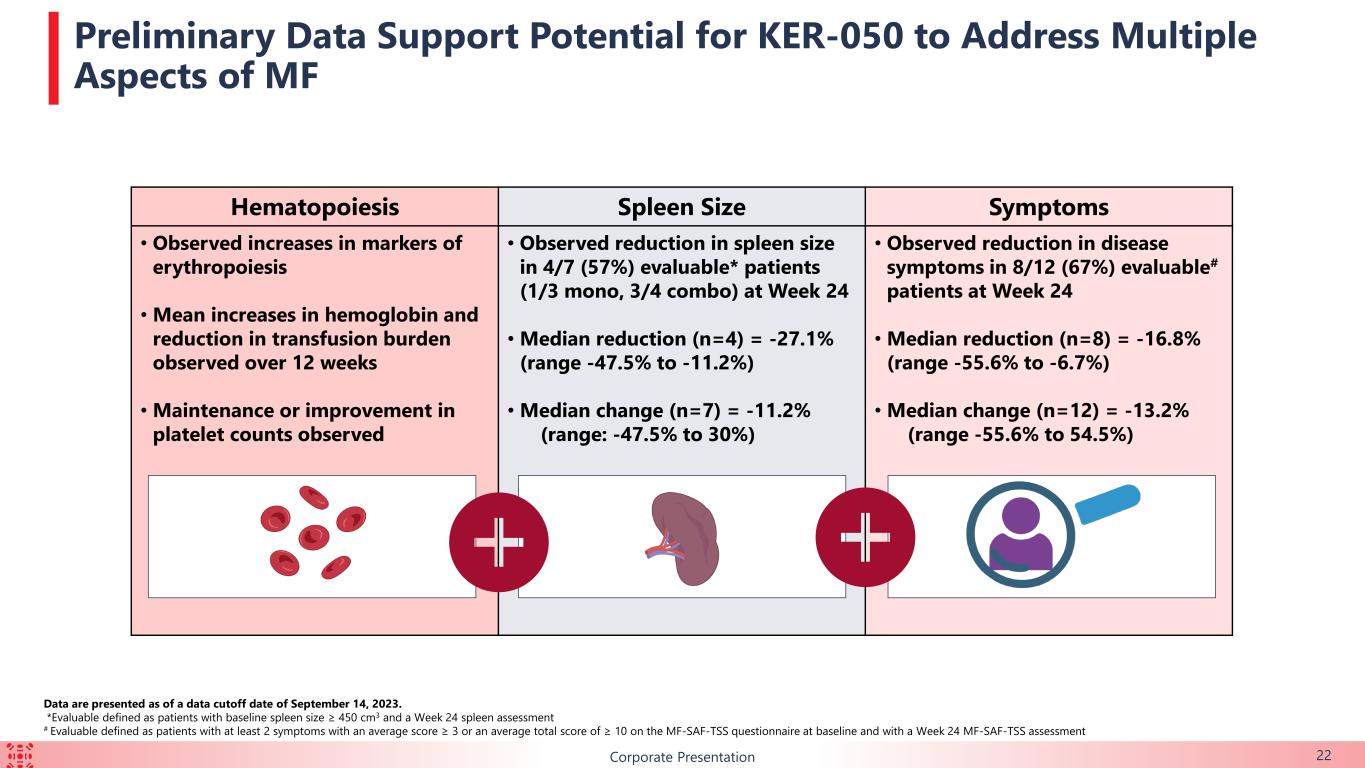
BCorporate Presentation Preliminary Data Support Potential for KER-050 to Address Multiple Aspects of MF Hematopoiesis Spleen Size Symptoms • Observed increases in markers of erythropoiesis • Mean increases in hemoglobin and reduction in transfusion burden observed over 12 weeks • Maintenance or improvement in platelet counts observed • Observed reduction in spleen size in 4/7 (57%) evaluable* patients (1/3 mono, 3/4 combo) at Week 24 • Median reduction (n=4) = -27.1% (range -47.5% to -11.2%) • Median change (n=7) = -11.2% (range: -47.5% to 30%) • Observed reduction in disease symptoms in 8/12 (67%) evaluable# patients at Week 24 • Median reduction (n=8) = -16.8% (range -55.6% to -6.7%) • Median change (n=12) = -13.2% (range -55.6% to 54.5%) Data are presented as of a data cutoff date of September 14, 2023. *Evaluable defined as patients with baseline spleen size ≥ 450 cm3 and a Week 24 spleen assessment # Evaluable defined as patients with at least 2 symptoms with an average score ≥ 3 or an average total score of ≥ 10 on the MF-SAF-TSS questionnaire at baseline and with a Week 24 MF-SAF-TSS assessment 22
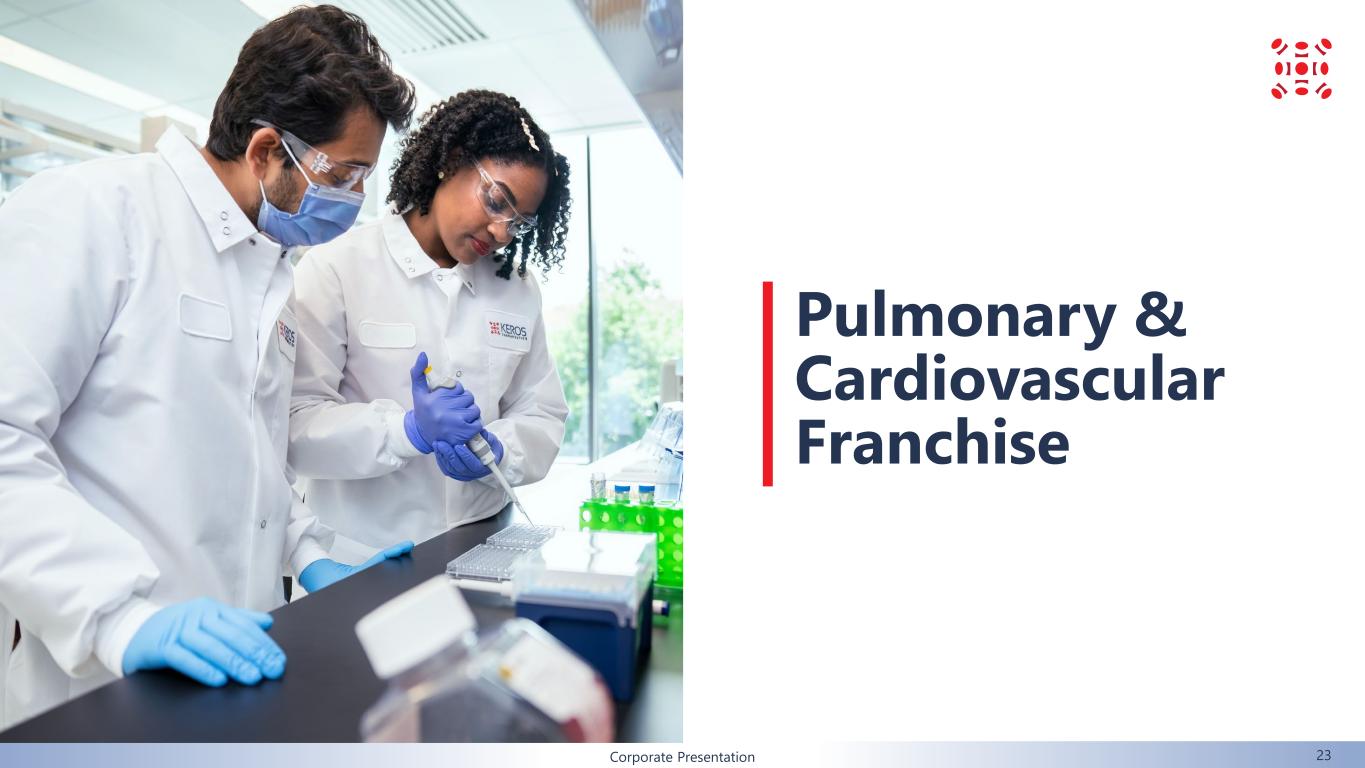
Pulmonary & Cardiovascular Franchise Corporate Presentation 23
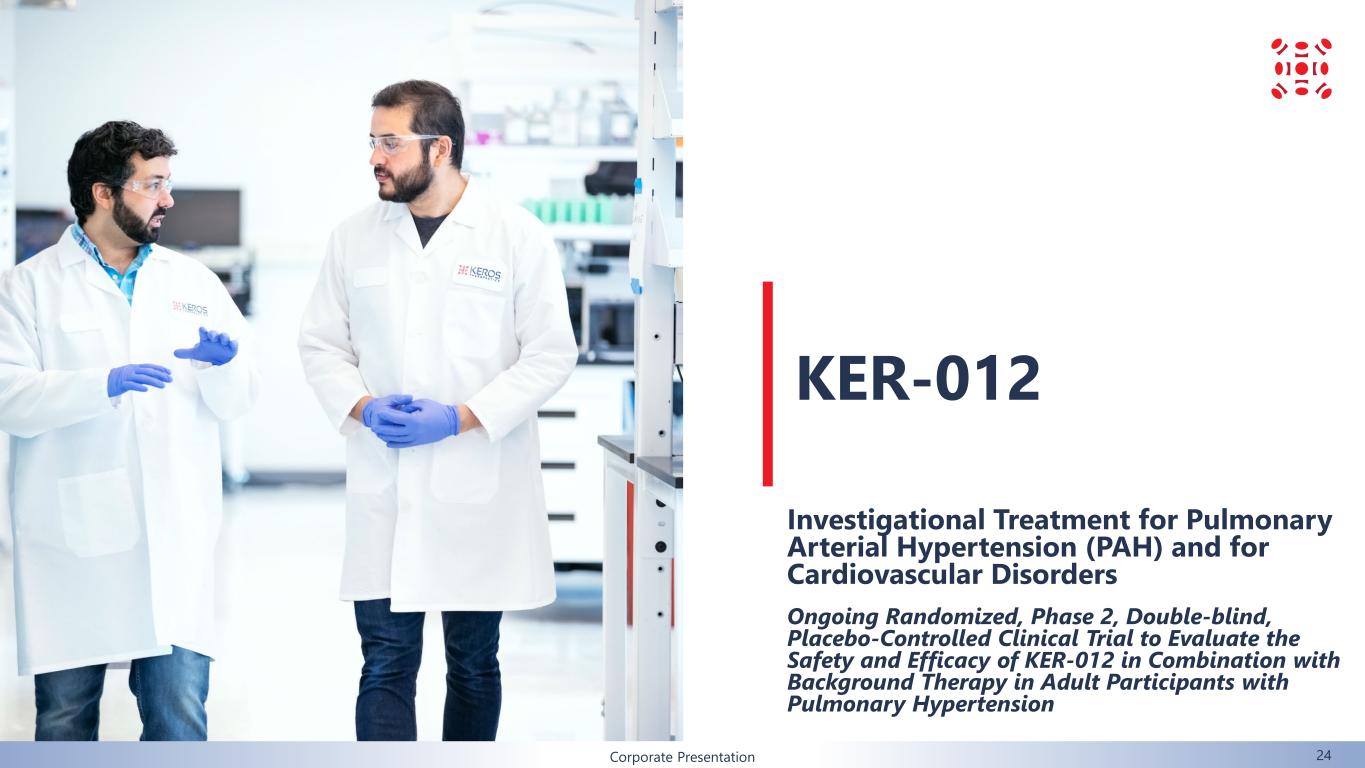
KER-012 Corporate Presentation Investigational Treatment for Pulmonary Arterial Hypertension (PAH) and for Cardiovascular Disorders Ongoing Randomized, Phase 2, Double-blind, Placebo-Controlled Clinical Trial to Evaluate the Safety and Efficacy of KER-012 in Combination with Background Therapy in Adult Participants with Pulmonary Hypertension 24
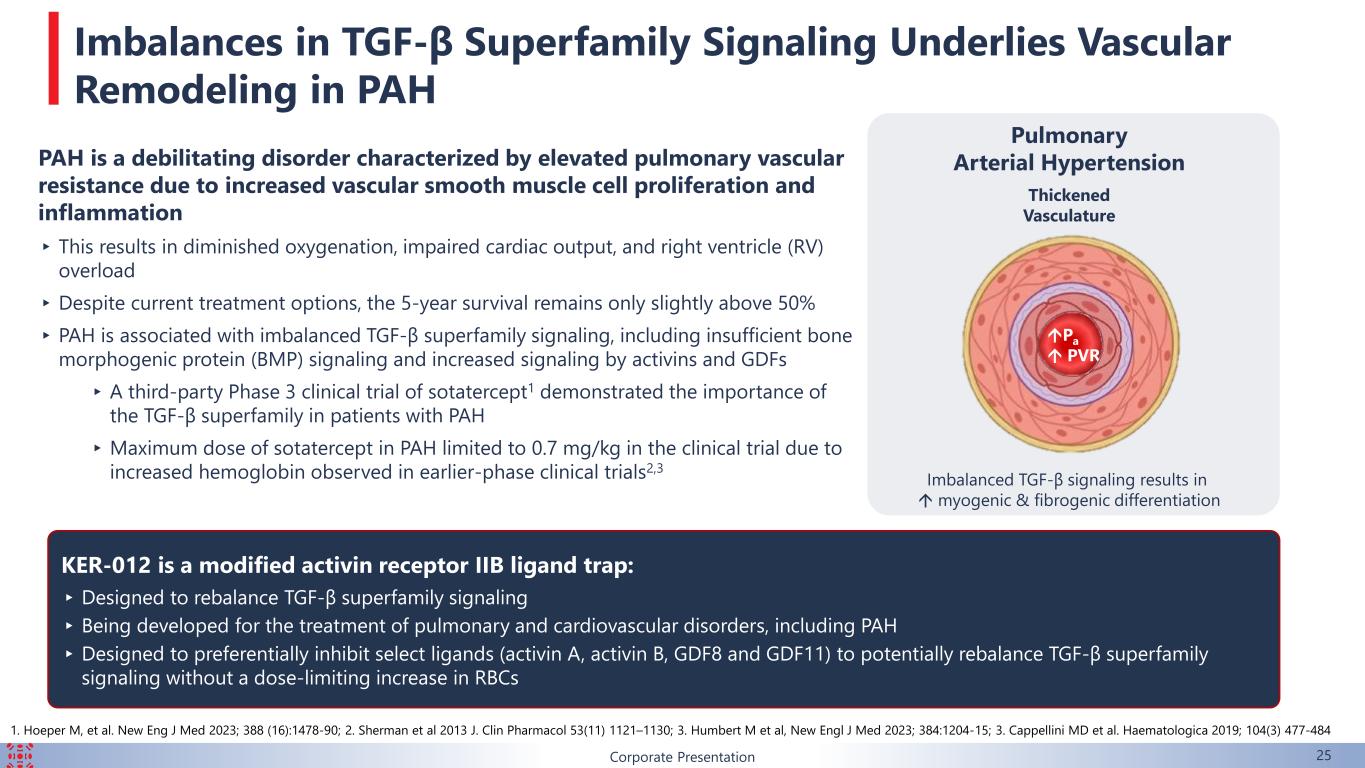
Corporate Presentation KER-012 is a modified activin receptor IIB ligand trap: ▸Designed to rebalance TGF-β superfamily signaling ▸ Being developed for the treatment of pulmonary and cardiovascular disorders, including PAH ▸Designed to preferentially inhibit select ligands (activin A, activin B, GDF8 and GDF11) to potentially rebalance TGF-β superfamily signaling without a dose-limiting increase in RBCs Thickened Vasculature Pulmonary Arterial Hypertension Pa PVR Imbalanced TGF-β signaling results in myogenic & fibrogenic differentiation PAH is a debilitating disorder characterized by elevated pulmonary vascular resistance due to increased vascular smooth muscle cell proliferation and inflammation ▸ This results in diminished oxygenation, impaired cardiac output, and right ventricle (RV) overload ▸Despite current treatment options, the 5-year survival remains only slightly above 50% ▸ PAH is associated with imbalanced TGF-β superfamily signaling, including insufficient bone morphogenic protein (BMP) signaling and increased signaling by activins and GDFs ▸A third-party Phase 3 clinical trial of sotatercept1 demonstrated the importance of the TGF-β superfamily in patients with PAH ▸Maximum dose of sotatercept in PAH limited to 0.7 mg/kg in the clinical trial due to increased hemoglobin observed in earlier-phase clinical trials2,3 Imbalances in TGF-β Superfamily Signaling Underlies Vascular Remodeling in PAH 1. Hoeper M, et al. New Eng J Med 2023; 388 (16):1478-90; 2. Sherman et al 2013 J. Clin Pharmacol 53(11) 1121–1130; 3. Humbert M et al, New Engl J Med 2023; 384:1204-15; 3. Cappellini MD et al. Haematologica 2019; 104(3) 477-484 25
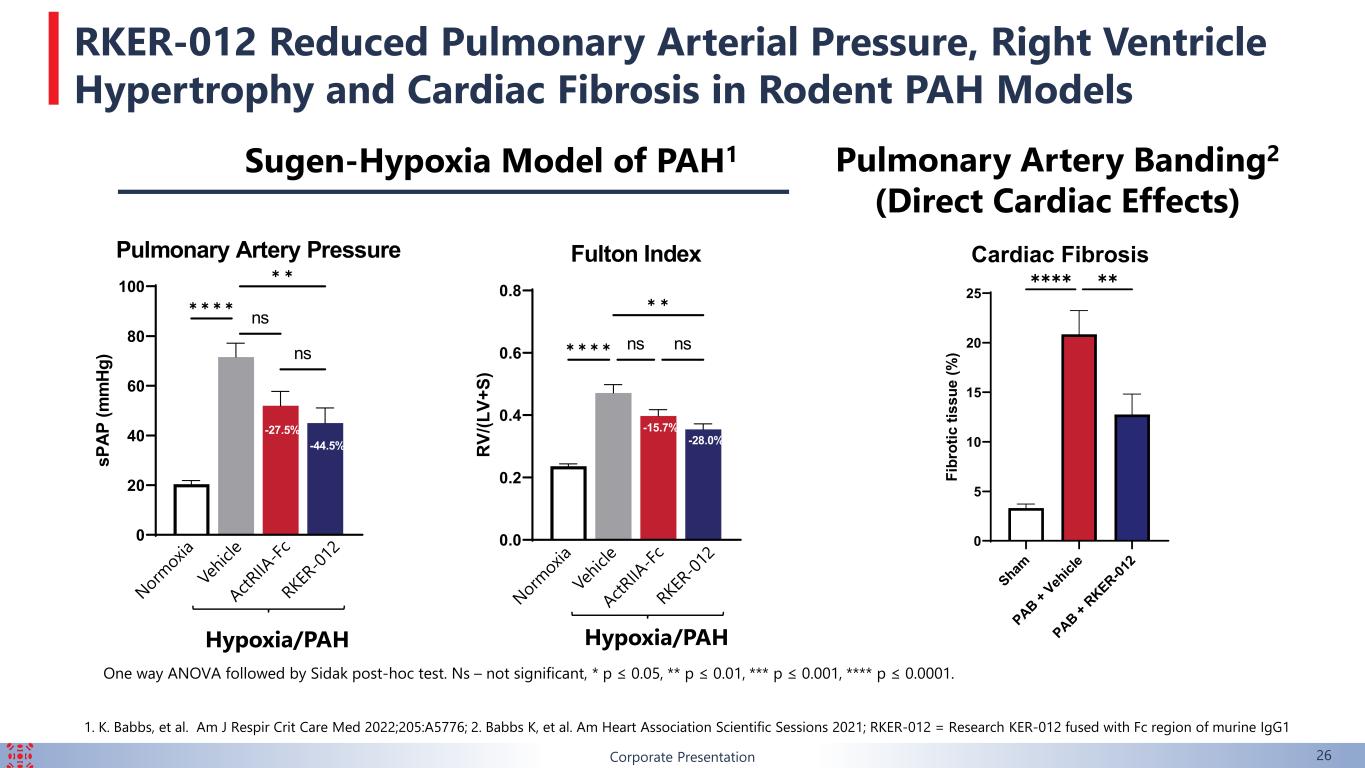
1. K. Babbs, et al. Am J Respir Crit Care Med 2022;205:A5776; 2. Babbs K, et al. Am Heart Association Scientific Sessions 2021; RKER-012 = Research KER-012 fused with Fc region of murine IgG1 0.0 0.2 0.4 0.6 0.8 Fulton Index R V/ (L V+ S) -15.7% -28.0% ✱ ✱ ✱ ✱ ns ✱ ✱ ns 0 20 40 60 80 100 Pulmonary Artery Pressure sP AP (m m Hg ) -27.5% -44.5% ✱ ✱ ✱ ✱ ns ✱ ✱ ns One way ANOVA followed by Sidak post-hoc test. Ns – not significant, * p ≤ 0.05, ** p ≤ 0.01, *** p ≤ 0.001, **** p ≤ 0.0001. Hypoxia/PAH Hypoxia/PAH Sugen-Hypoxia Model of PAH1 Pulmonary Artery Banding2 (Direct Cardiac Effects) Cardiac Fibrosis Sham PAB + Veh icl e PAB + RKER-01 2 0 5 10 15 20 25 Fi br ot ic ti ss ue (% ) -38.9% ✱✱✱✱ ✱✱ Corporate Presentation RKER-012 Reduced Pulmonary Arterial Pressure, Right Ventricle Hypertrophy and Cardiac Fibrosis in Rodent PAH Models 26
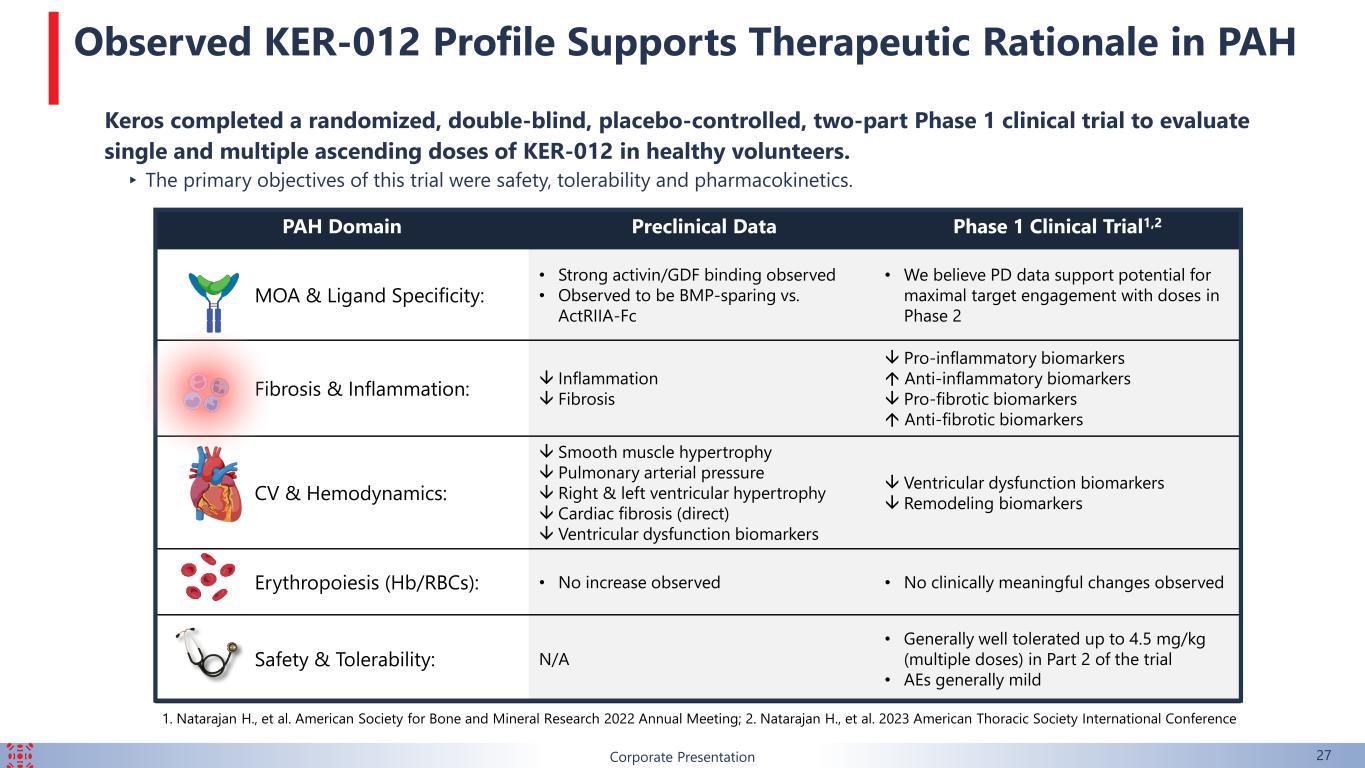
PAH Domain Preclinical Data Phase 1 Clinical Trial1,2 MOA & Ligand Specificity: • Strong activin/GDF binding observed • Observed to be BMP-sparing vs. ActRIIA-Fc • We believe PD data support potential for maximal target engagement with doses in Phase 2 Fibrosis & Inflammation: Inflammation Fibrosis Pro-inflammatory biomarkers Anti-inflammatory biomarkers Pro-fibrotic biomarkers Anti-fibrotic biomarkers CV & Hemodynamics: Smooth muscle hypertrophy Pulmonary arterial pressure Right & left ventricular hypertrophy Cardiac fibrosis (direct) Ventricular dysfunction biomarkers Ventricular dysfunction biomarkers Remodeling biomarkers Erythropoiesis (Hb/RBCs): • No increase observed • No clinically meaningful changes observed Safety & Tolerability: N/A • Generally well tolerated up to 4.5 mg/kg (multiple doses) in Part 2 of the trial • AEs generally mild Corporate Presentation Keros completed a randomized, double-blind, placebo-controlled, two-part Phase 1 clinical trial to evaluate single and multiple ascending doses of KER-012 in healthy volunteers. ▸ The primary objectives of this trial were safety, tolerability and pharmacokinetics. 1. Natarajan H., et al. American Society for Bone and Mineral Research 2022 Annual Meeting; 2. Natarajan H., et al. 2023 American Thoracic Society International Conference Observed KER-012 Profile Supports Therapeutic Rationale in PAH 27
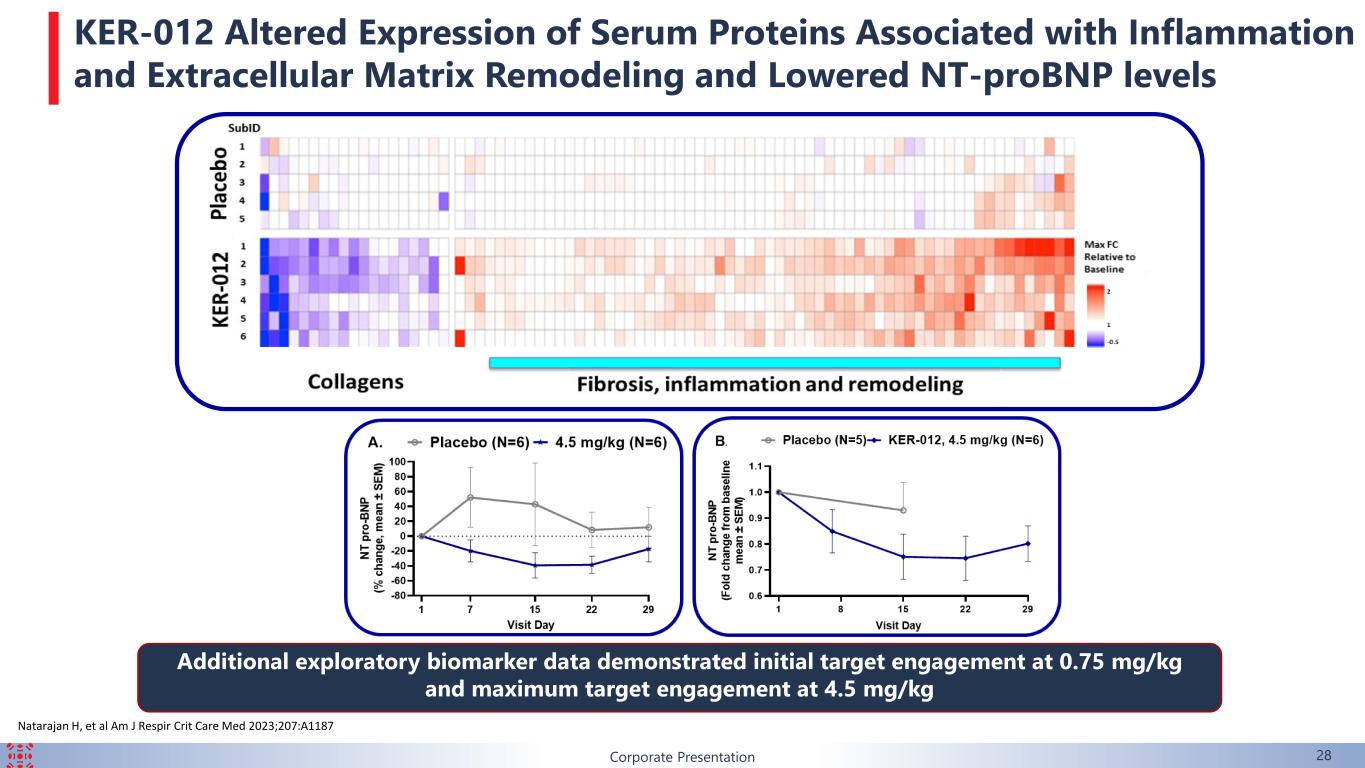
Natarajan H, et al Am J Respir Crit Care Med 2023;207:A1187 Additional exploratory biomarker data demonstrated initial target engagement at 0.75 mg/kg and maximum target engagement at 4.5 mg/kg Corporate Presentation KER-012 Altered Expression of Serum Proteins Associated with Inflammation and Extracellular Matrix Remodeling and Lowered NT-proBNP levels 28
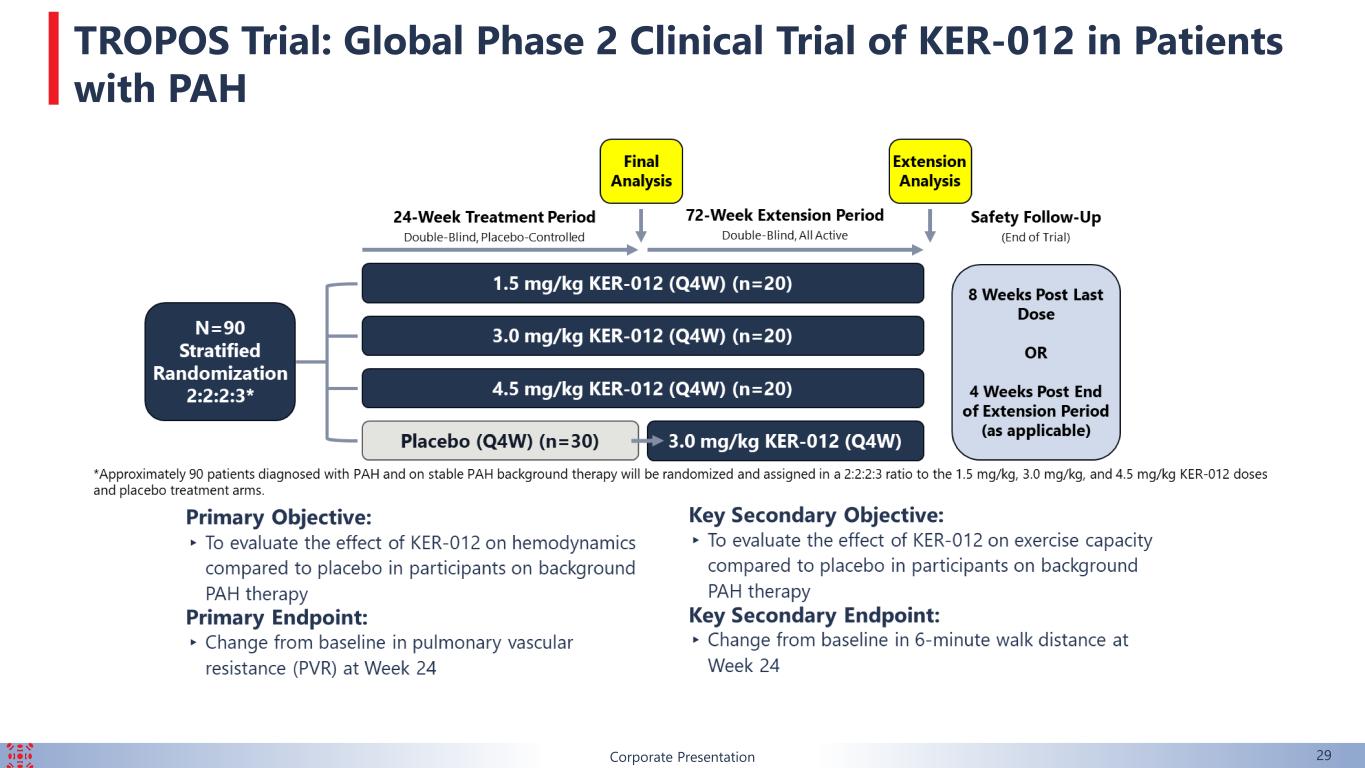
Corporate Presentation TROPOS Trial: Global Phase 2 Clinical Trial of KER-012 in Patients with PAH 29
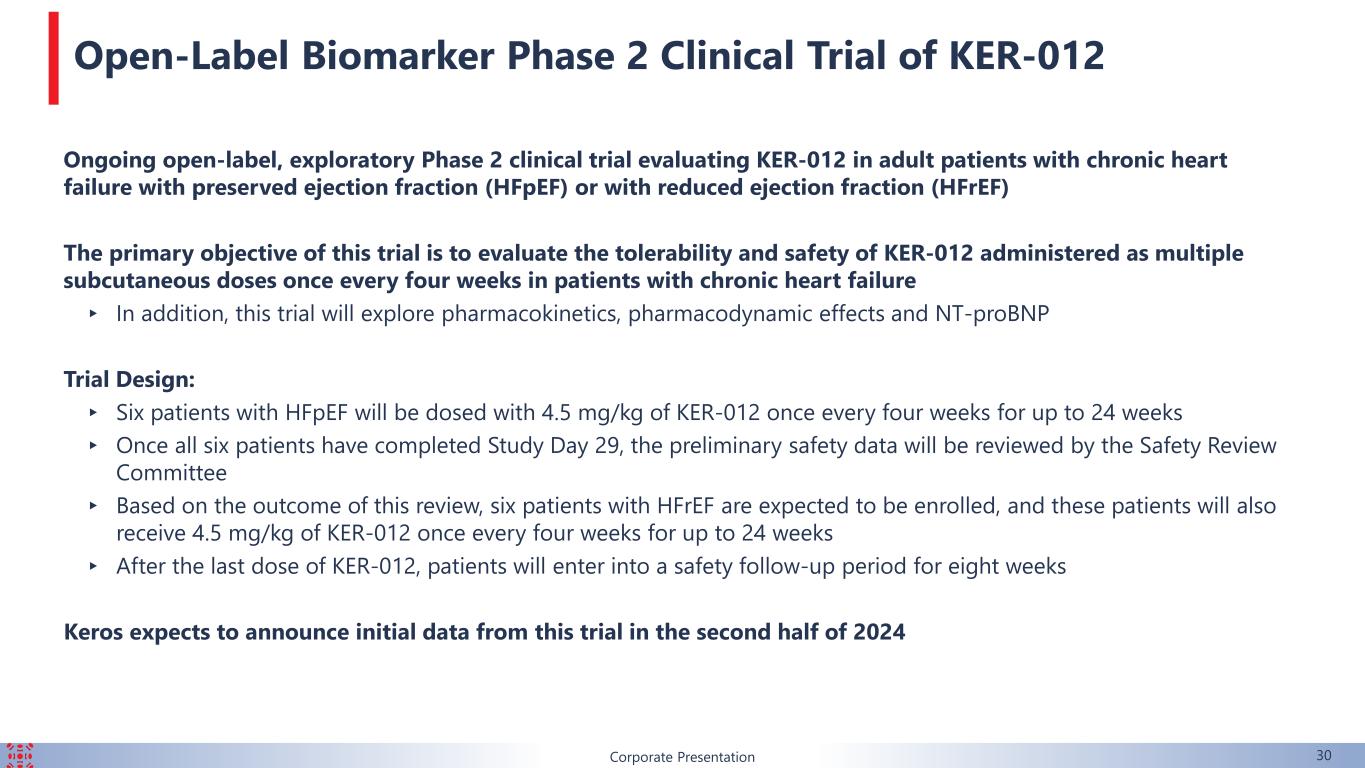
Corporate Presentation Open-Label Biomarker Phase 2 Clinical Trial of KER-012 Ongoing open-label, exploratory Phase 2 clinical trial evaluating KER-012 in adult patients with chronic heart failure with preserved ejection fraction (HFpEF) or with reduced ejection fraction (HFrEF) The primary objective of this trial is to evaluate the tolerability and safety of KER-012 administered as multiple subcutaneous doses once every four weeks in patients with chronic heart failure ▸ In addition, this trial will explore pharmacokinetics, pharmacodynamic effects and NT-proBNP Trial Design: ▸ Six patients with HFpEF will be dosed with 4.5 mg/kg of KER-012 once every four weeks for up to 24 weeks ▸ Once all six patients have completed Study Day 29, the preliminary safety data will be reviewed by the Safety Review Committee ▸ Based on the outcome of this review, six patients with HFrEF are expected to be enrolled, and these patients will also receive 4.5 mg/kg of KER-012 once every four weeks for up to 24 weeks ▸ After the last dose of KER-012, patients will enter into a safety follow-up period for eight weeks Keros expects to announce initial data from this trial in the second half of 2024 30
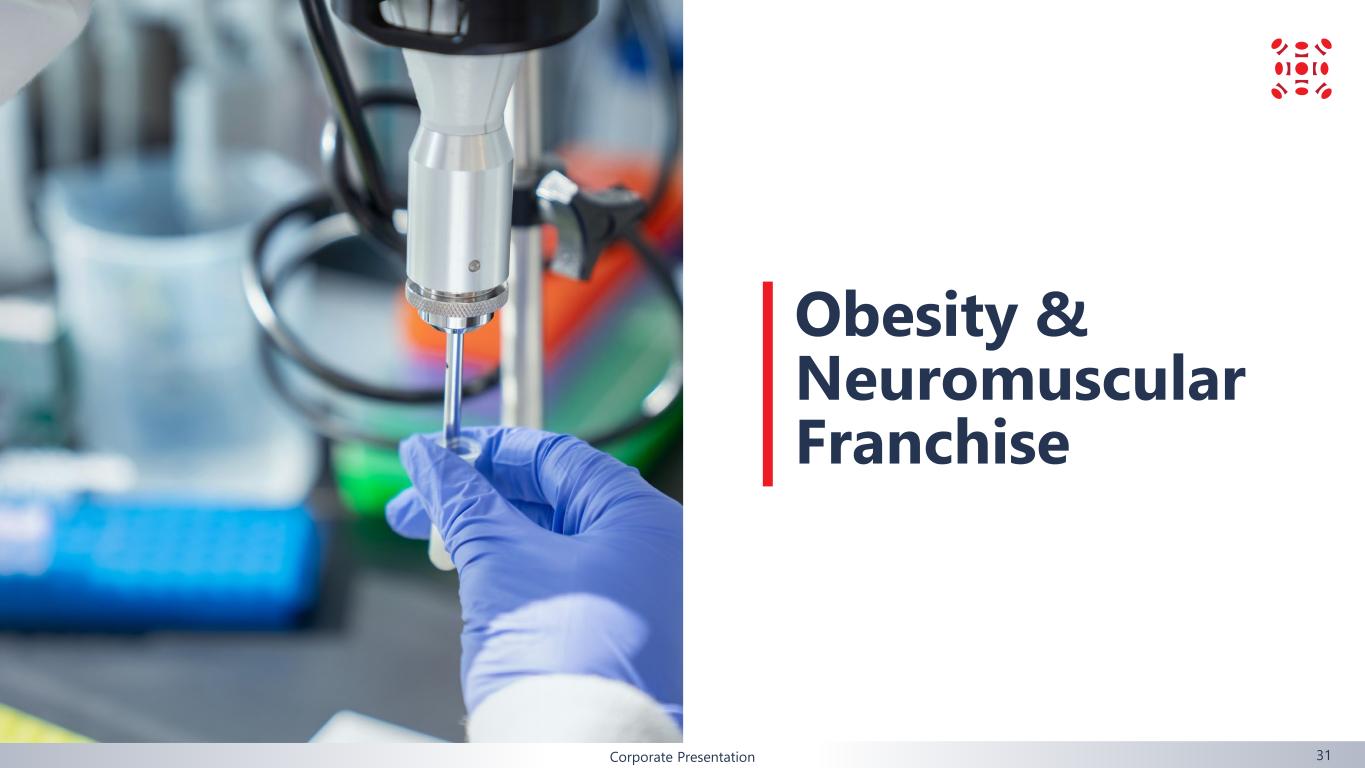
Obesity & Neuromuscular Franchise Corporate Presentation 31
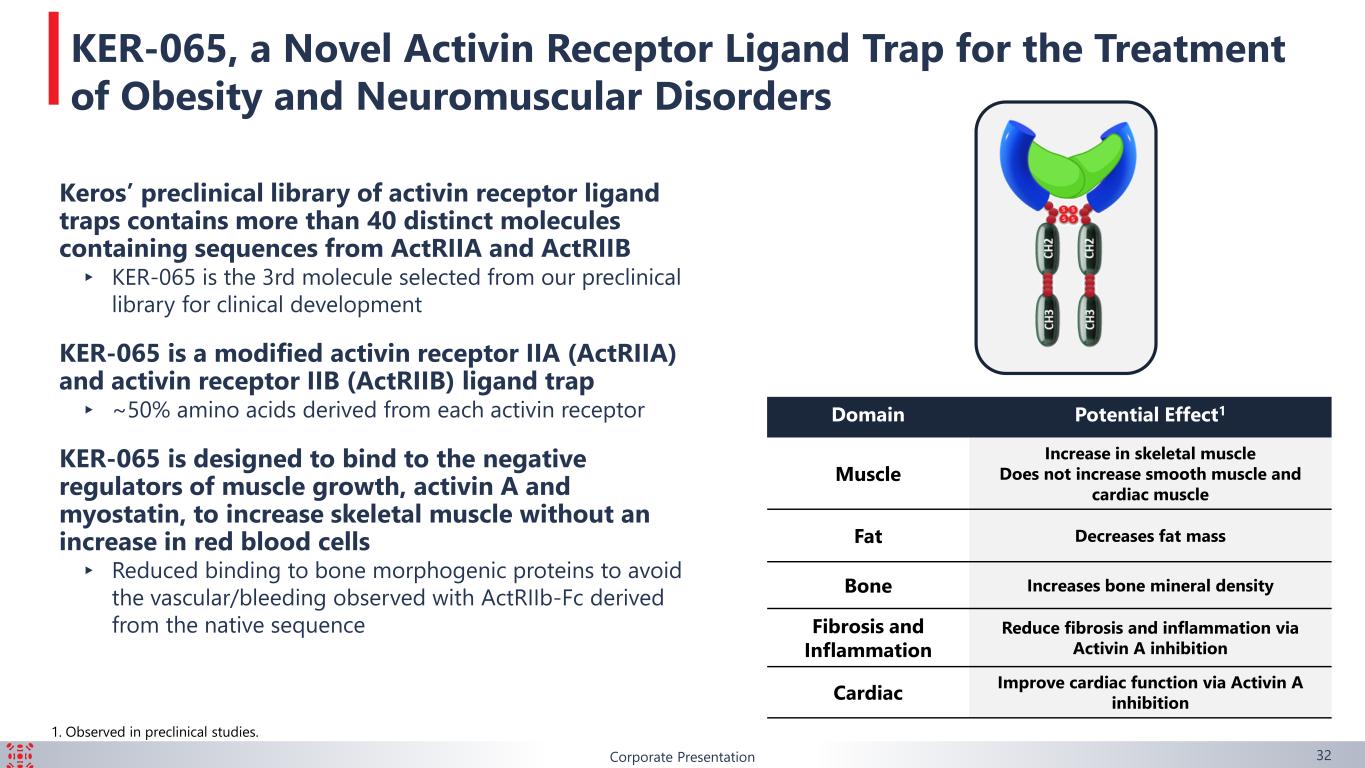
Corporate Presentation KER-065, a Novel Activin Receptor Ligand Trap for the Treatment of Obesity and Neuromuscular Disorders Keros’ preclinical library of activin receptor ligand traps contains more than 40 distinct molecules containing sequences from ActRIIA and ActRIIB ▸ KER-065 is the 3rd molecule selected from our preclinical library for clinical development KER-065 is a modified activin receptor IIA (ActRIIA) and activin receptor IIB (ActRIIB) ligand trap ▸ ~50% amino acids derived from each activin receptor KER-065 is designed to bind to the negative regulators of muscle growth, activin A and myostatin, to increase skeletal muscle without an increase in red blood cells ▸ Reduced binding to bone morphogenic proteins to avoid the vascular/bleeding observed with ActRIIb-Fc derived from the native sequence Domain Potential Effect1 Muscle Increase in skeletal muscle Does not increase smooth muscle and cardiac muscle Fat Decreases fat mass Bone Increases bone mineral density Fibrosis and Inflammation Reduce fibrosis and inflammation via Activin A inhibition Cardiac Improve cardiac function via Activin A inhibition 1. Observed in preclinical studies. 32
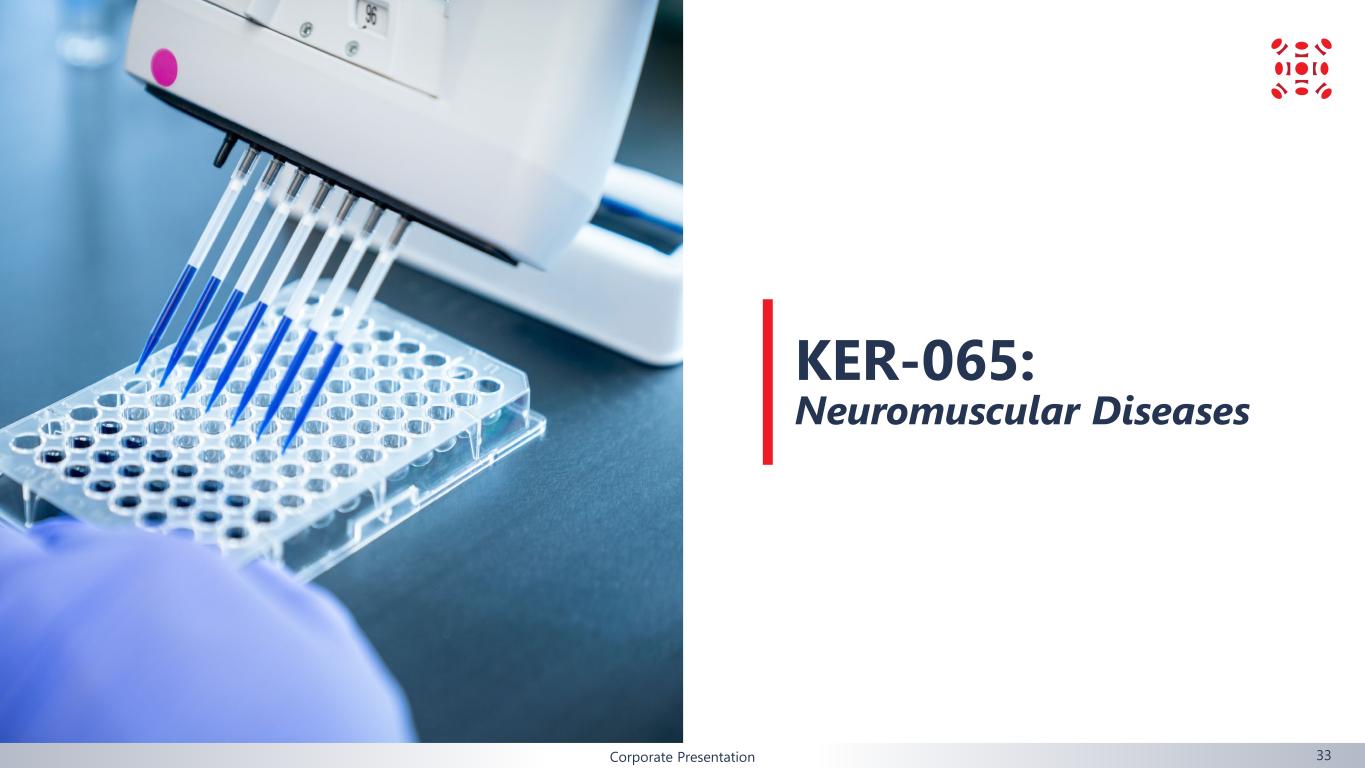
Corporate Presentation KER-065: Neuromuscular Diseases 33
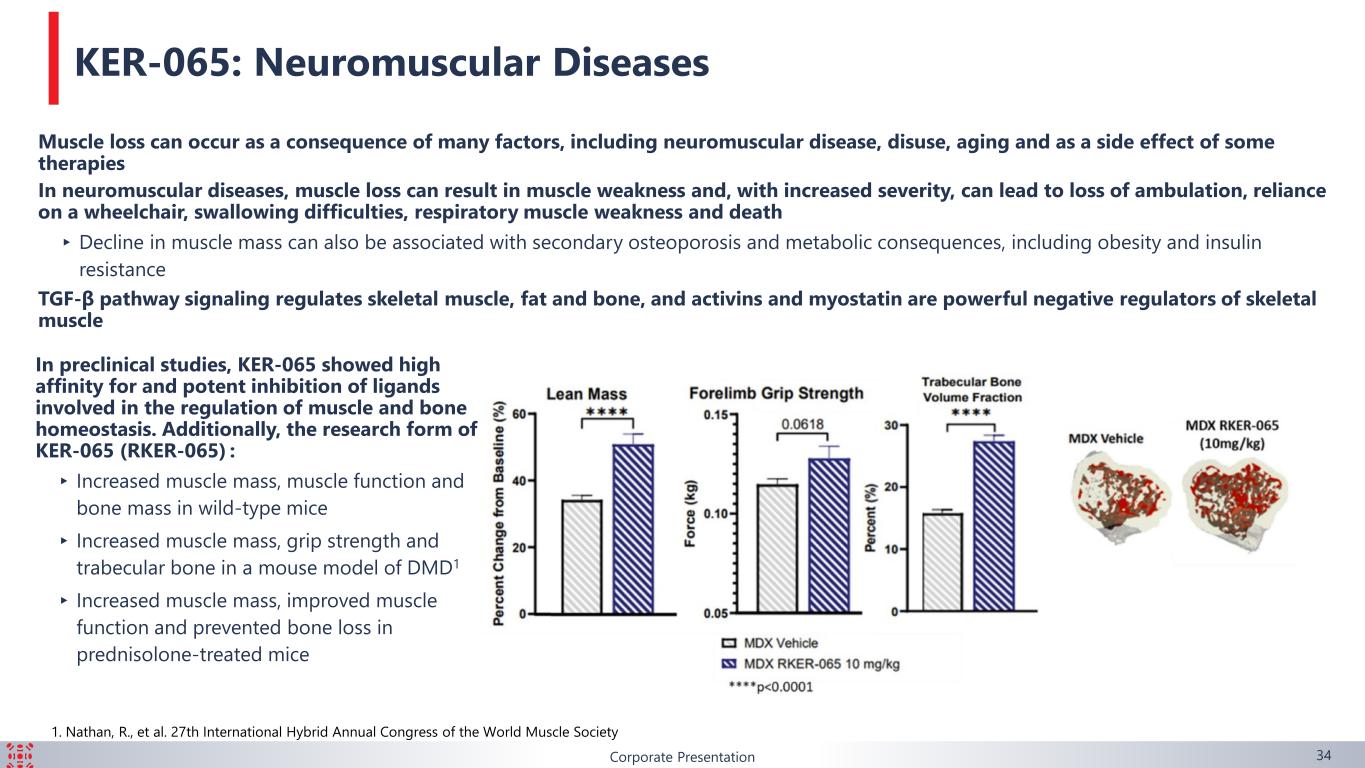
Corporate Presentation Muscle loss can occur as a consequence of many factors, including neuromuscular disease, disuse, aging and as a side effect of some therapies In neuromuscular diseases, muscle loss can result in muscle weakness and, with increased severity, can lead to loss of ambulation, reliance on a wheelchair, swallowing difficulties, respiratory muscle weakness and death ▸Decline in muscle mass can also be associated with secondary osteoporosis and metabolic consequences, including obesity and insulin resistance TGF-β pathway signaling regulates skeletal muscle, fat and bone, and activins and myostatin are powerful negative regulators of skeletal muscle In preclinical studies, KER-065 showed high affinity for and potent inhibition of ligands involved in the regulation of muscle and bone homeostasis. Additionally, the research form of KER-065 (RKER-065) : ▸ Increased muscle mass, muscle function and bone mass in wild-type mice ▸ Increased muscle mass, grip strength and trabecular bone in a mouse model of DMD1 ▸ Increased muscle mass, improved muscle function and prevented bone loss in prednisolone-treated mice KER-065: Neuromuscular Diseases 1. Nathan, R., et al. 27th International Hybrid Annual Congress of the World Muscle Society 34
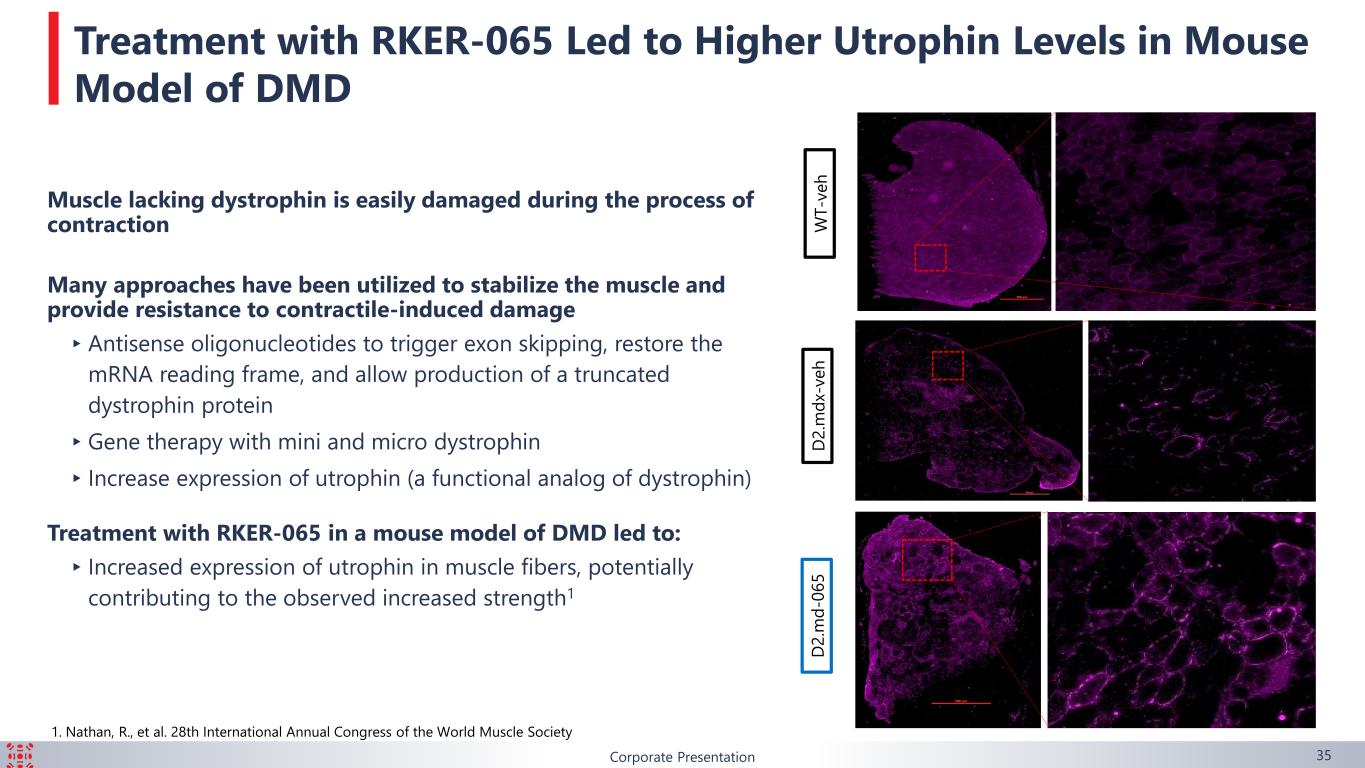
Corporate Presentation W T- ve h D2 .m dx -v eh D2 .m d- 06 5 Treatment with RKER-065 Led to Higher Utrophin Levels in Mouse Model of DMD Muscle lacking dystrophin is easily damaged during the process of contraction Many approaches have been utilized to stabilize the muscle and provide resistance to contractile-induced damage ▸Antisense oligonucleotides to trigger exon skipping, restore the mRNA reading frame, and allow production of a truncated dystrophin protein ▸Gene therapy with mini and micro dystrophin ▸Increase expression of utrophin (a functional analog of dystrophin) Treatment with RKER-065 in a mouse model of DMD led to: ▸Increased expression of utrophin in muscle fibers, potentially contributing to the observed increased strength1 1. Nathan, R., et al. 28th International Annual Congress of the World Muscle Society 35
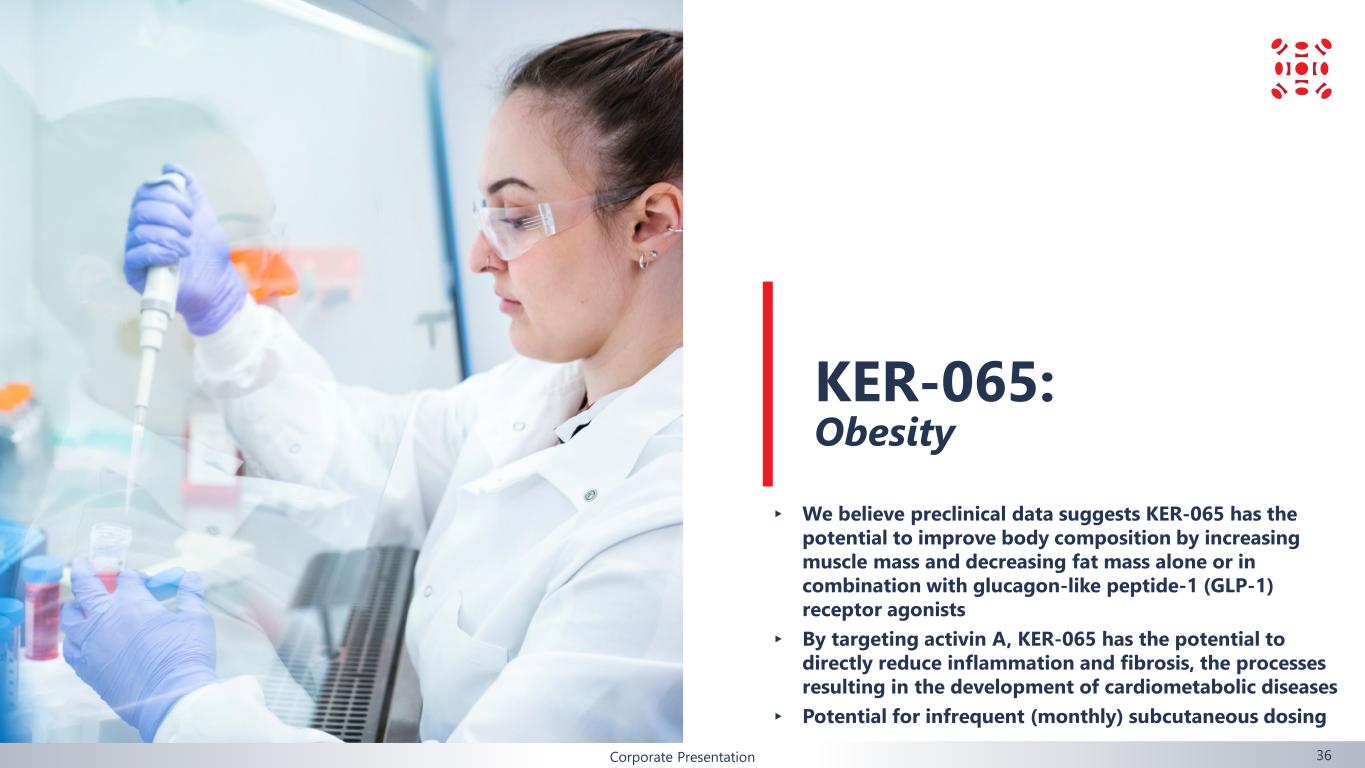
Corporate Presentation ▸ We believe preclinical data suggests KER-065 has the potential to improve body composition by increasing muscle mass and decreasing fat mass alone or in combination with glucagon-like peptide-1 (GLP-1) receptor agonists ▸ By targeting activin A, KER-065 has the potential to directly reduce inflammation and fibrosis, the processes resulting in the development of cardiometabolic diseases ▸ Potential for infrequent (monthly) subcutaneous dosing KER-065: Obesity 36
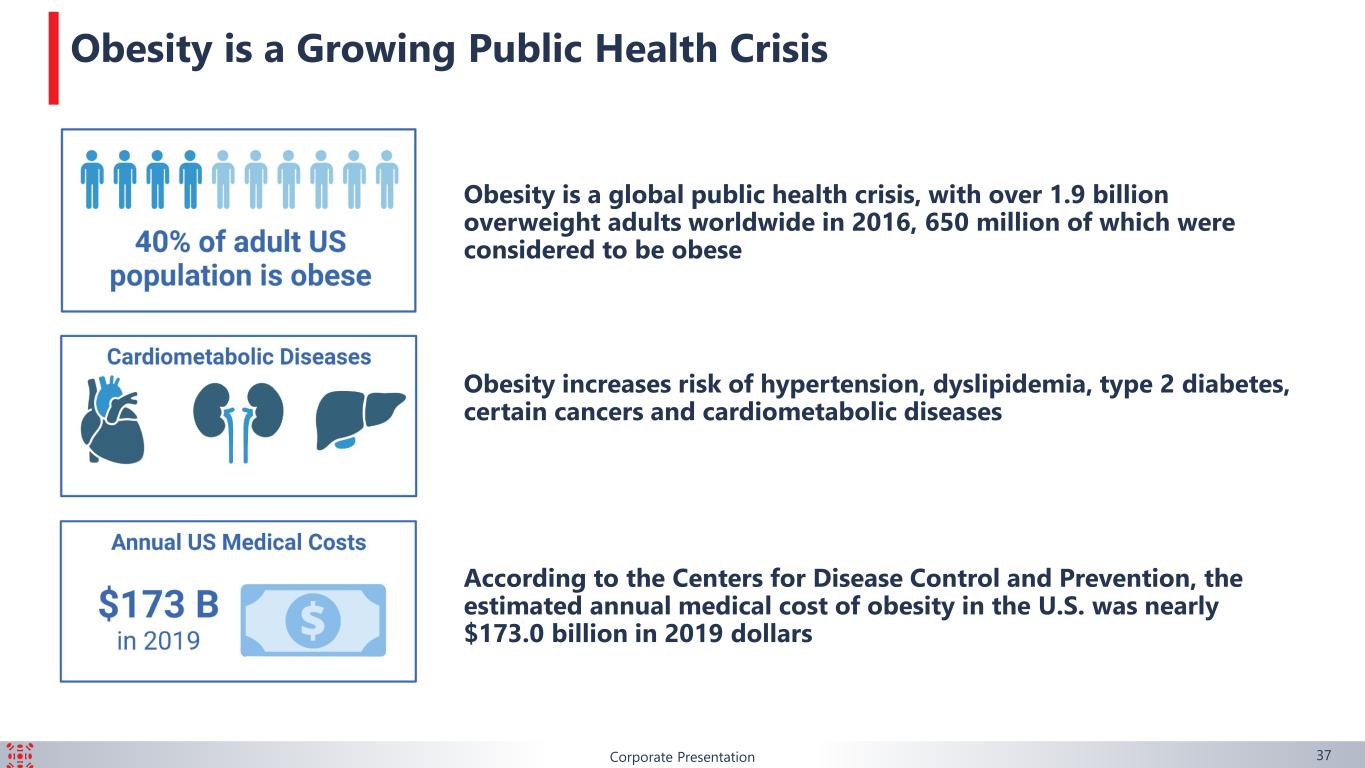
Corporate Presentation Obesity is a Growing Public Health Crisis Obesity is a global public health crisis, with over 1.9 billion overweight adults worldwide in 2016, 650 million of which were considered to be obese Obesity increases risk of hypertension, dyslipidemia, type 2 diabetes, certain cancers and cardiometabolic diseases According to the Centers for Disease Control and Prevention, the estimated annual medical cost of obesity in the U.S. was nearly $173.0 billion in 2019 dollars 37
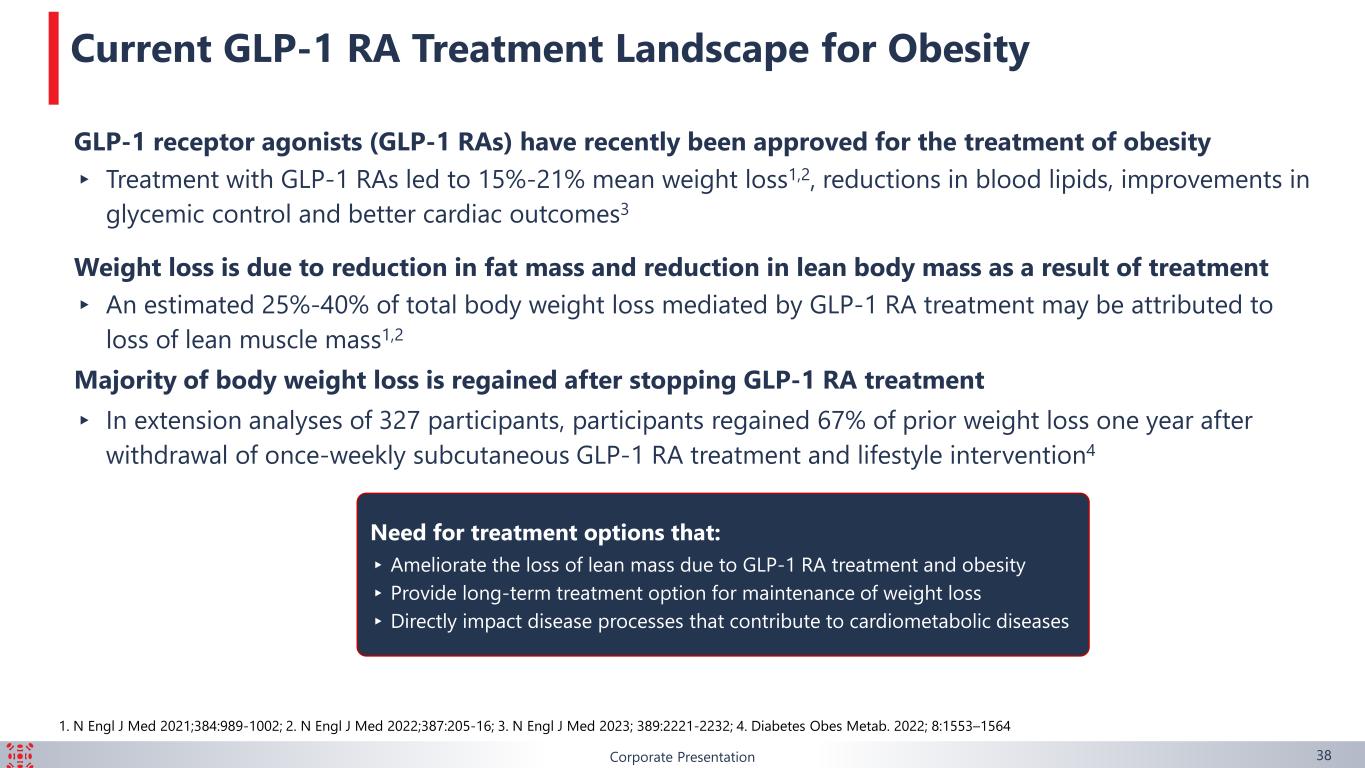
Corporate Presentation Current GLP-1 RA Treatment Landscape for Obesity GLP-1 receptor agonists (GLP-1 RAs) have recently been approved for the treatment of obesity ▸ Treatment with GLP-1 RAs led to 15%-21% mean weight loss1,2, reductions in blood lipids, improvements in glycemic control and better cardiac outcomes3 Weight loss is due to reduction in fat mass and reduction in lean body mass as a result of treatment ▸ An estimated 25%-40% of total body weight loss mediated by GLP-1 RA treatment may be attributed to loss of lean muscle mass1,2 Majority of body weight loss is regained after stopping GLP-1 RA treatment ▸ In extension analyses of 327 participants, participants regained 67% of prior weight loss one year after withdrawal of once-weekly subcutaneous GLP-1 RA treatment and lifestyle intervention4 1. N Engl J Med 2021;384:989-1002; 2. N Engl J Med 2022;387:205-16; 3. N Engl J Med 2023; 389:2221-2232; 4. Diabetes Obes Metab. 2022; 8:1553–1564 Need for treatment options that: ▸Ameliorate the loss of lean mass due to GLP-1 RA treatment and obesity ▸ Provide long-term treatment option for maintenance of weight loss ▸Directly impact disease processes that contribute to cardiometabolic diseases 38
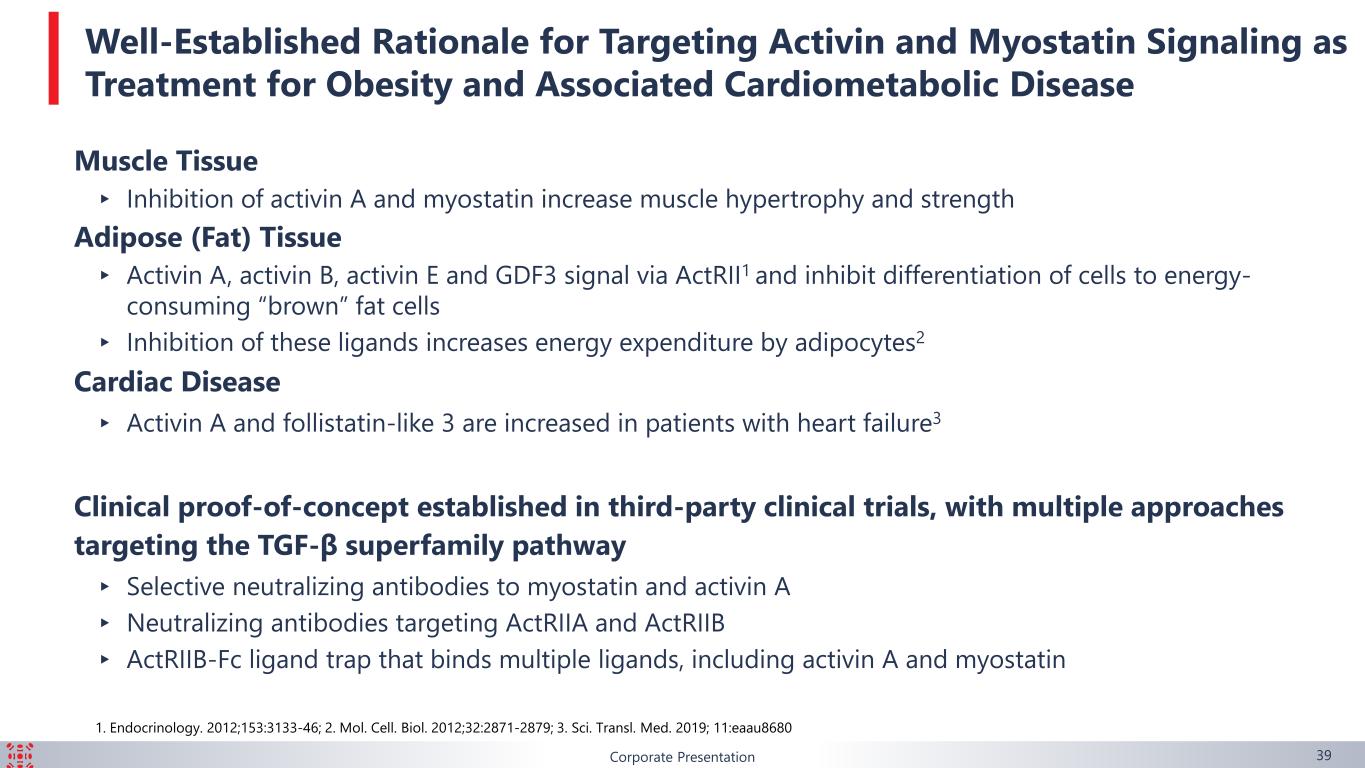
Corporate Presentation Well-Established Rationale for Targeting Activin and Myostatin Signaling as Treatment for Obesity and Associated Cardiometabolic Disease Muscle Tissue ▸ Inhibition of activin A and myostatin increase muscle hypertrophy and strength Adipose (Fat) Tissue ▸ Activin A, activin B, activin E and GDF3 signal via ActRII1 and inhibit differentiation of cells to energy- consuming “brown” fat cells ▸ Inhibition of these ligands increases energy expenditure by adipocytes2 Cardiac Disease ▸ Activin A and follistatin-like 3 are increased in patients with heart failure3 Clinical proof-of-concept established in third-party clinical trials, with multiple approaches targeting the TGF-β superfamily pathway ▸ Selective neutralizing antibodies to myostatin and activin A ▸ Neutralizing antibodies targeting ActRIIA and ActRIIB ▸ ActRIIB-Fc ligand trap that binds multiple ligands, including activin A and myostatin 1. Endocrinology. 2012;153:3133-46; 2. Mol. Cell. Biol. 2012;32:2871-2879; 3. Sci. Transl. Med. 2019; 11:eaau8680 39
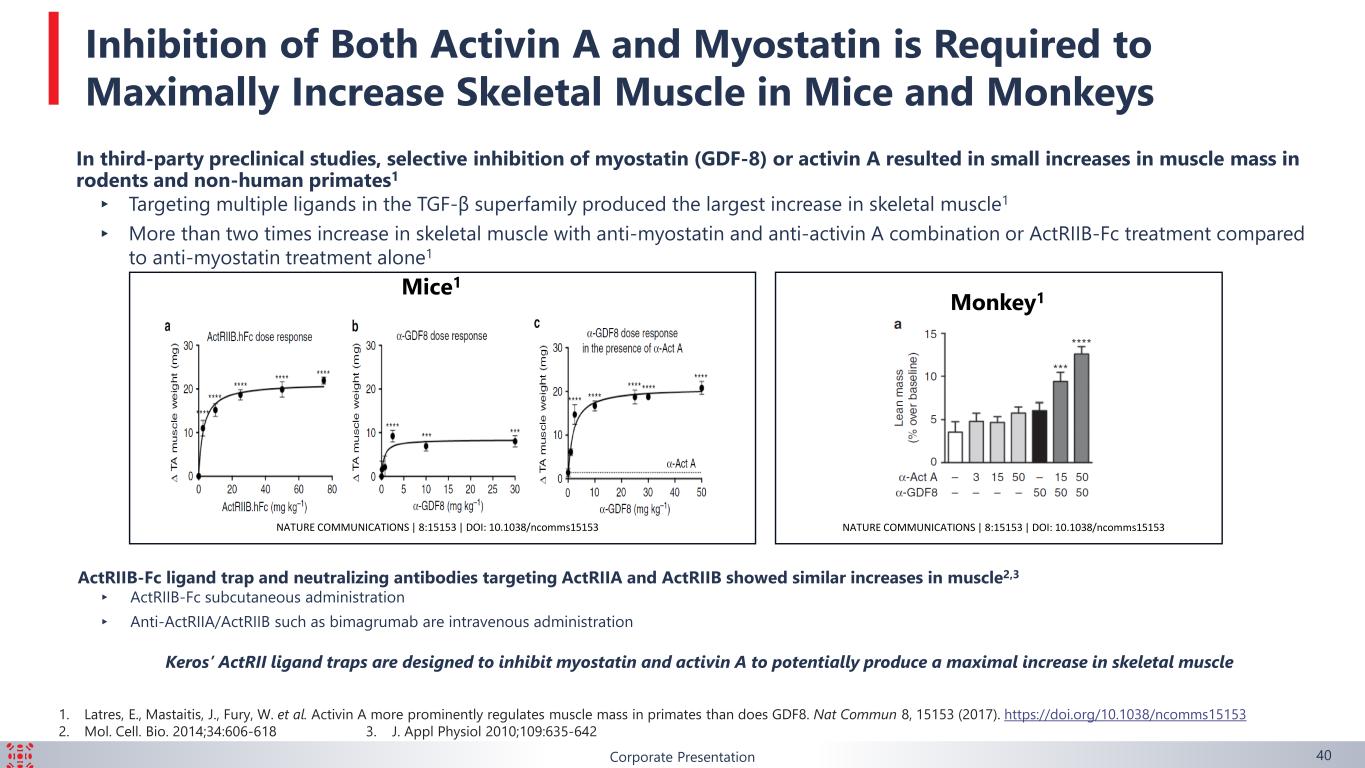
Corporate Presentation Inhibition of Both Activin A and Myostatin is Required to Maximally Increase Skeletal Muscle in Mice and Monkeys 1. Latres, E., Mastaitis, J., Fury, W. et al. Activin A more prominently regulates muscle mass in primates than does GDF8. Nat Commun 8, 15153 (2017). https://doi.org/10.1038/ncomms15153 2. Mol. Cell. Bio. 2014;34:606-618 3. J. Appl Physiol 2010;109:635-642 ActRIIB-Fc ligand trap and neutralizing antibodies targeting ActRIIA and ActRIIB showed similar increases in muscle2,3 ▸ ActRIIB-Fc subcutaneous administration ▸ Anti-ActRIIA/ActRIIB such as bimagrumab are intravenous administration Keros’ ActRII ligand traps are designed to inhibit myostatin and activin A to potentially produce a maximal increase in skeletal muscle In third-party preclinical studies, selective inhibition of myostatin (GDF-8) or activin A resulted in small increases in muscle mass in rodents and non-human primates1 ▸ Targeting multiple ligands in the TGF-β superfamily produced the largest increase in skeletal muscle1 ▸ More than two times increase in skeletal muscle with anti-myostatin and anti-activin A combination or ActRIIB-Fc treatment compared to anti-myostatin treatment alone1 Mice1 NATURE COMMUNICATIONS | 8:15153 | DOI: 10.1038/ncomms15153 Monkey1 NATURE COMMUNICATIONS | 8:15153 | DOI: 10.1038/ncomms15153 40
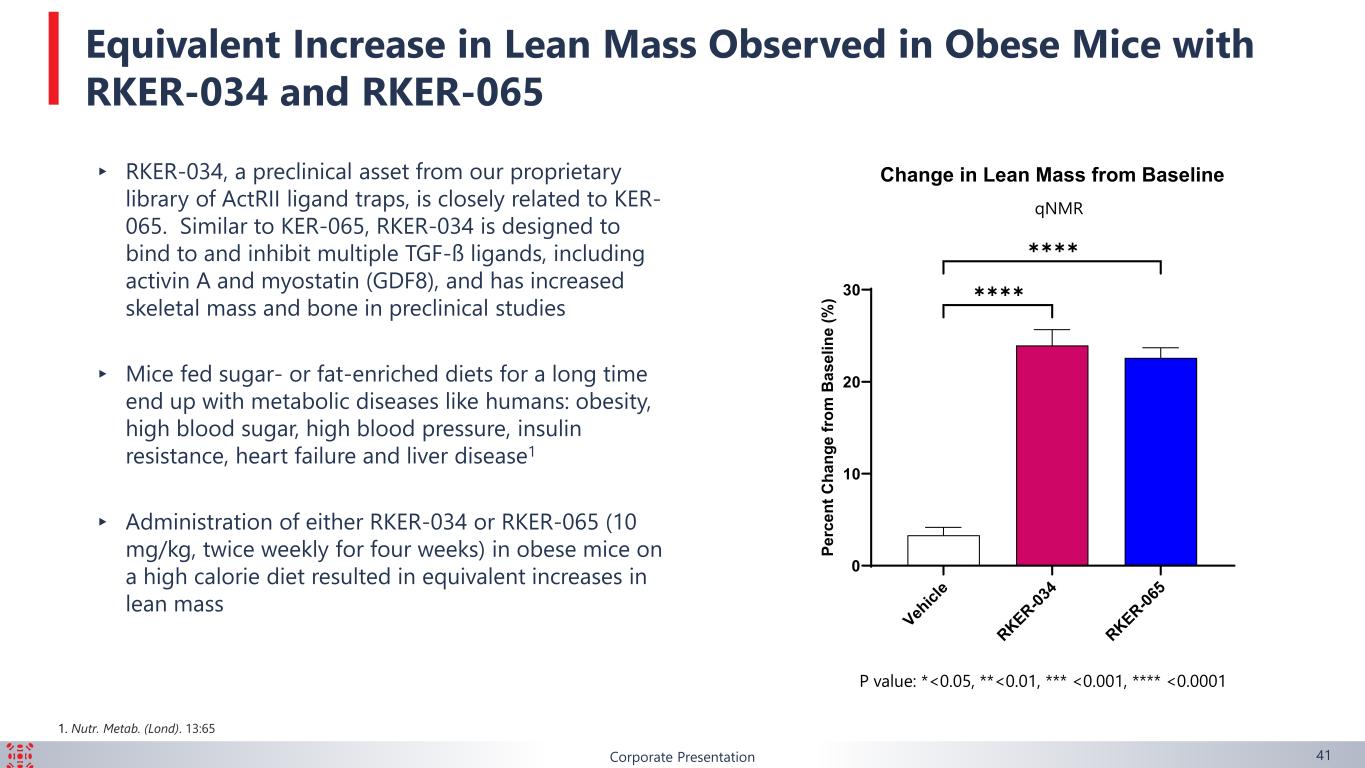
Corporate Presentation Equivalent Increase in Lean Mass Observed in Obese Mice with RKER-034 and RKER-065 P value: *<0.05, **<0.01, *** <0.001, **** <0.0001 qNMR Veh icl e RKER-03 4 RKER-06 5 0 10 20 30 Change in Lean Mass from Baseline Pe rc en t C ha ng e fr om B as el in e (% ) ✱✱✱✱ ✱✱✱✱ ▸ RKER-034, a preclinical asset from our proprietary library of ActRII ligand traps, is closely related to KER- 065. Similar to KER-065, RKER-034 is designed to bind to and inhibit multiple TGF-ß ligands, including activin A and myostatin (GDF8), and has increased skeletal mass and bone in preclinical studies ▸ Mice fed sugar- or fat-enriched diets for a long time end up with metabolic diseases like humans: obesity, high blood sugar, high blood pressure, insulin resistance, heart failure and liver disease1 ▸ Administration of either RKER-034 or RKER-065 (10 mg/kg, twice weekly for four weeks) in obese mice on a high calorie diet resulted in equivalent increases in lean mass 1. Nutr. Metab. (Lond). 13:65 41
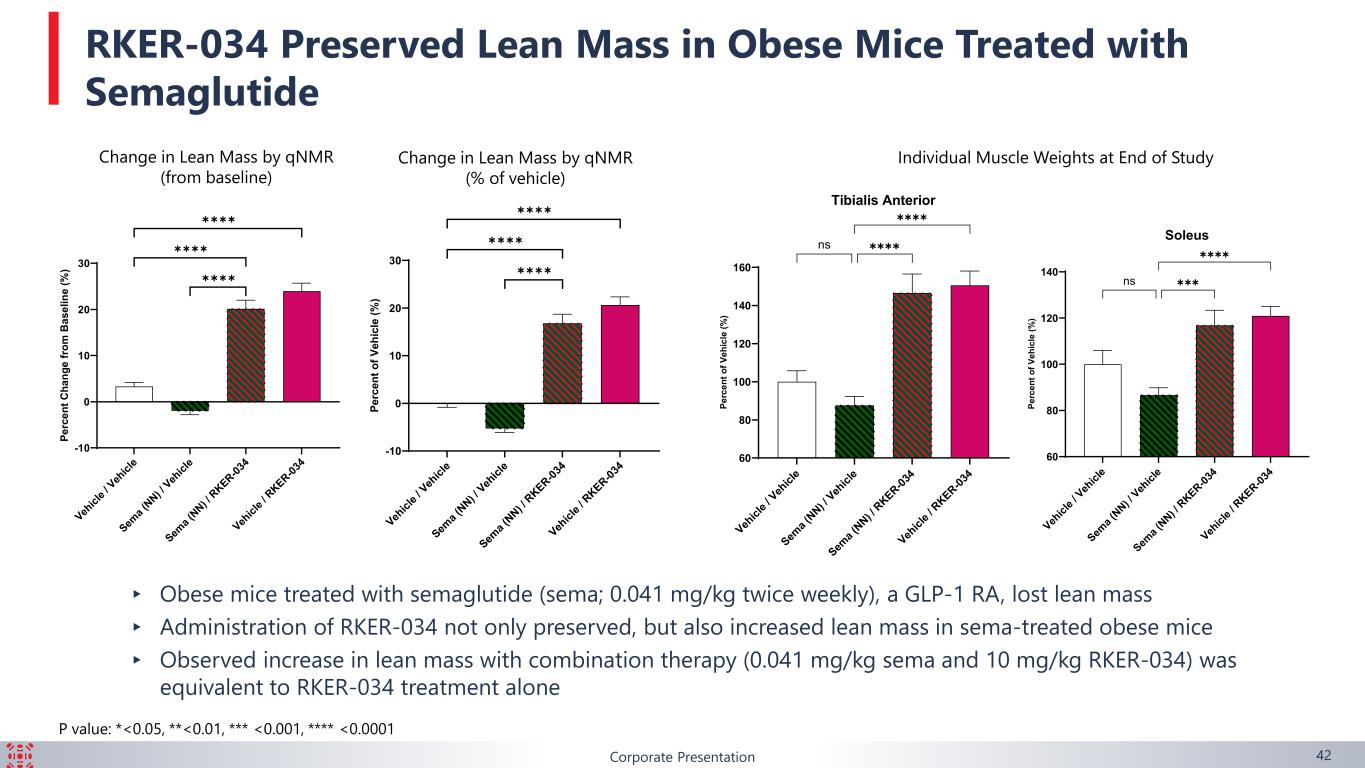
Veh icl e / Veh icl e Sem a ( NN) / Veh icl e Sem a ( NN) / RKER-03 4 Veh icl e / RKER-03 4 -10 0 10 20 30 Change in Lean Mass from Baseline as a Percent of Vehicle Pe rc en t o f V eh ic le (% ) ✱✱✱✱ ✱✱✱✱ ✱✱✱✱ Corporate Presentation RKER-034 Preserved Lean Mass in Obese Mice Treated with Semaglutide Veh icl e / Veh icl e Sem a ( NN) / Veh icl e Sem a ( NN) / RKER-03 4 Veh icl e / RKER-03 4 -10 0 10 20 30 Change in Lean Mass from Baseline Pe rc en t C ha ng e fr om B as el in e (% ) ✱✱✱✱ ✱✱✱✱ ✱✱✱✱ Change in Lean Mass by qNMR (from baseline) Individual Muscle Weights at End of Study ▸ Obese mice treated with semaglutide (sema; 0.041 mg/kg twice weekly), a GLP-1 RA, lost lean mass ▸ Administration of RKER-034 not only preserved, but also increased lean mass in sema-treated obese mice ▸ Observed increase in lean mass with combination therapy (0.041 mg/kg sema and 10 mg/kg RKER-034) was equivalent to RKER-034 treatment alone P value: *<0.05, **<0.01, *** <0.001, **** <0.0001 Change in Lean Mass by qNMR (% of vehicle) Veh icl e / Veh icl e Sem a ( NN) / Veh icl e Sem a ( NN) / RKER-03 4 Veh icl e / RKER-03 4 60 80 100 120 140 160 Tibialis Anterior Pe rc en t o f V eh ic le (% ) ns ✱✱✱✱ ✱✱✱✱ Veh icl e / Veh icl e Sem a ( NN) / Veh icl e Sem a ( NN) / RKER-03 4 Veh icl e / RKER-03 4 60 80 100 120 140 Soleus Pe rc en t o f V eh ic le (% ) ns ✱✱✱ ✱✱✱✱ 42
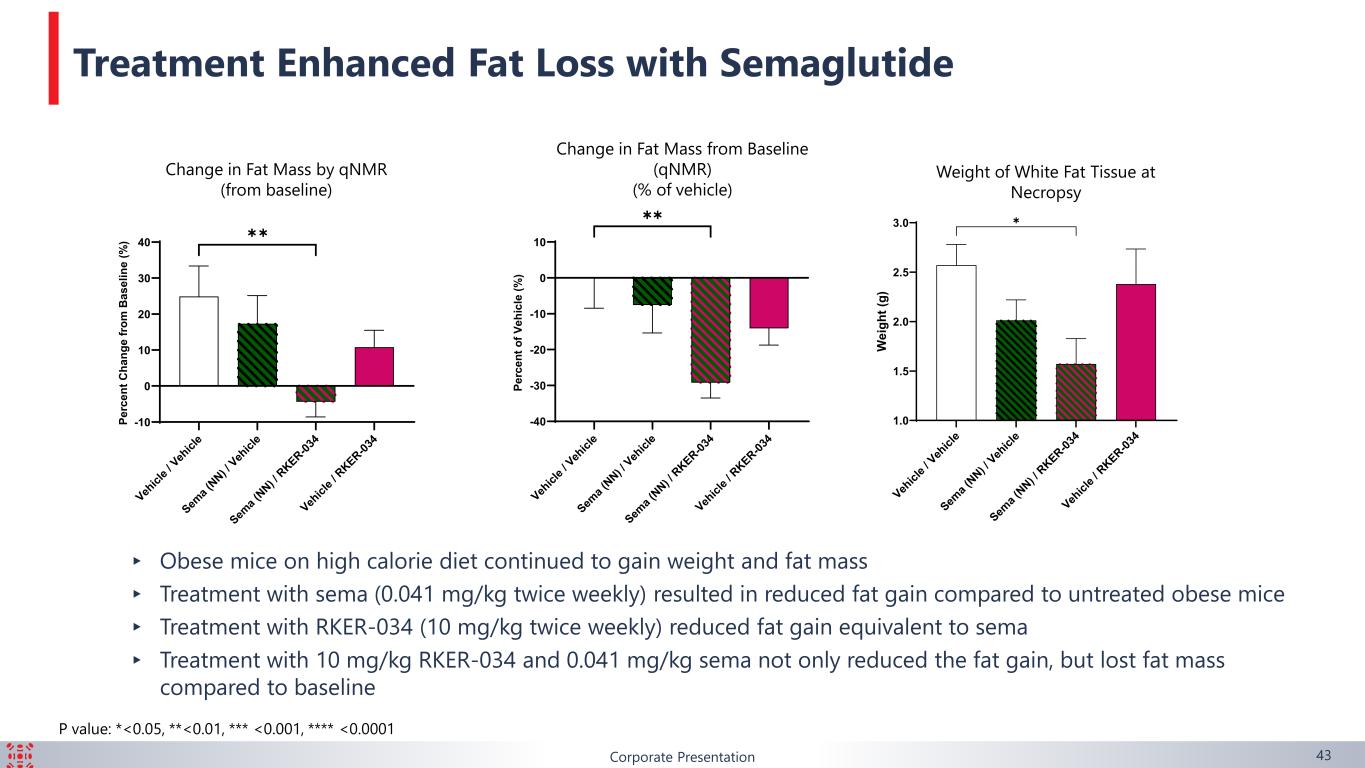
Veh icl e / Veh icl e Sem a ( NN) / Veh icl e Sem a ( NN) / RKER-03 4 Veh icl e / RKER-03 4 -40 -30 -20 -10 0 10 Change in Fat Mass from Baseline as a Percent of Vehicle Pe rc en t o f V eh ic le (% ) ✱✱ Corporate Presentation Treatment Enhanced Fat Loss with Semaglutide ▸ Obese mice on high calorie diet continued to gain weight and fat mass ▸ Treatment with sema (0.041 mg/kg twice weekly) resulted in reduced fat gain compared to untreated obese mice ▸ Treatment with RKER-034 (10 mg/kg twice weekly) reduced fat gain equivalent to sema ▸ Treatment with 10 mg/kg RKER-034 and 0.041 mg/kg sema not only reduced the fat gain, but lost fat mass compared to baseline P value: *<0.05, **<0.01, *** <0.001, **** <0.0001 Veh icl e / Veh icl e Sem a ( NN) / Veh icl e Sem a ( NN) / RKER-03 4 Veh icl e / RKER-03 4 -10 0 10 20 30 40 Change in Fat Mass from Baseline Pe rc en t C ha ng e fr om B as el in e (% ) ✱✱ Veh icl e / Veh icl e Sem a ( NN) / Veh icl e Sem a ( NN) / RKER-03 4 Veh icl e / RKER-03 4 1.0 1.5 2.0 2.5 3.0 Inguinal White Adipose Tissue W ei gh t ( g) ✱ Change in Fat Mass by qNMR (from baseline) Weight of White Fat Tissue at Necropsy Change in Fat Mass from Baseline (qNMR) (% of vehicle) 43
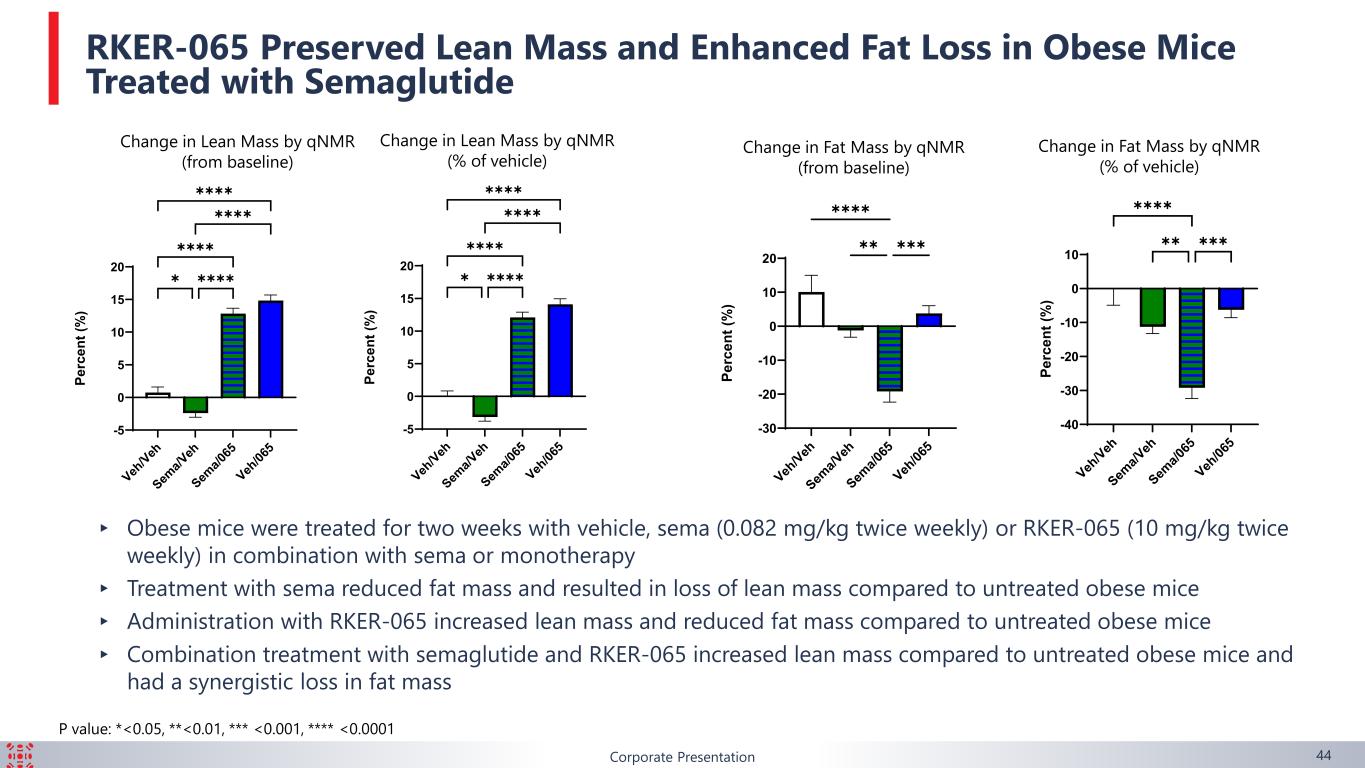
Corporate Presentation RKER-065 Preserved Lean Mass and Enhanced Fat Loss in Obese Mice Treated with Semaglutide Veh /Veh Sem a/V eh Sem a/0 65 Veh /06 5 -30 -20 -10 0 10 20 Pe rc en t ( % ) ✱✱✱✱ ✱✱ ✱✱✱ Veh /Veh Sem a/V eh Sem a/0 65 Veh /06 5 -5 0 5 10 15 20 Pe rc en t ( % ) ✱✱✱✱ ✱✱✱✱ ✱✱✱✱ ✱✱✱✱✱ Change in Fat Mass by qNMR (from baseline) Change in Lean Mass by qNMR (from baseline) ▸ Obese mice were treated for two weeks with vehicle, sema (0.082 mg/kg twice weekly) or RKER-065 (10 mg/kg twice weekly) in combination with sema or monotherapy ▸ Treatment with sema reduced fat mass and resulted in loss of lean mass compared to untreated obese mice ▸ Administration with RKER-065 increased lean mass and reduced fat mass compared to untreated obese mice ▸ Combination treatment with semaglutide and RKER-065 increased lean mass compared to untreated obese mice and had a synergistic loss in fat mass Veh /Veh Sem a/V eh Sem a/0 65 Veh /06 5 -5 0 5 10 15 20 Pe rc en t ( % ) ✱✱✱✱ ✱✱✱✱ ✱✱✱✱ ✱✱✱✱✱ Change in Lean Mass by qNMR (% of vehicle) Veh /Veh Sem a/V eh Sem a/0 65 Veh /06 5 -40 -30 -20 -10 0 10 Pe rc en t ( % ) ✱✱✱✱ ✱✱ ✱✱✱ Change in Fat Mass by qNMR (% of vehicle) P value: *<0.05, **<0.01, *** <0.001, **** <0.0001 44
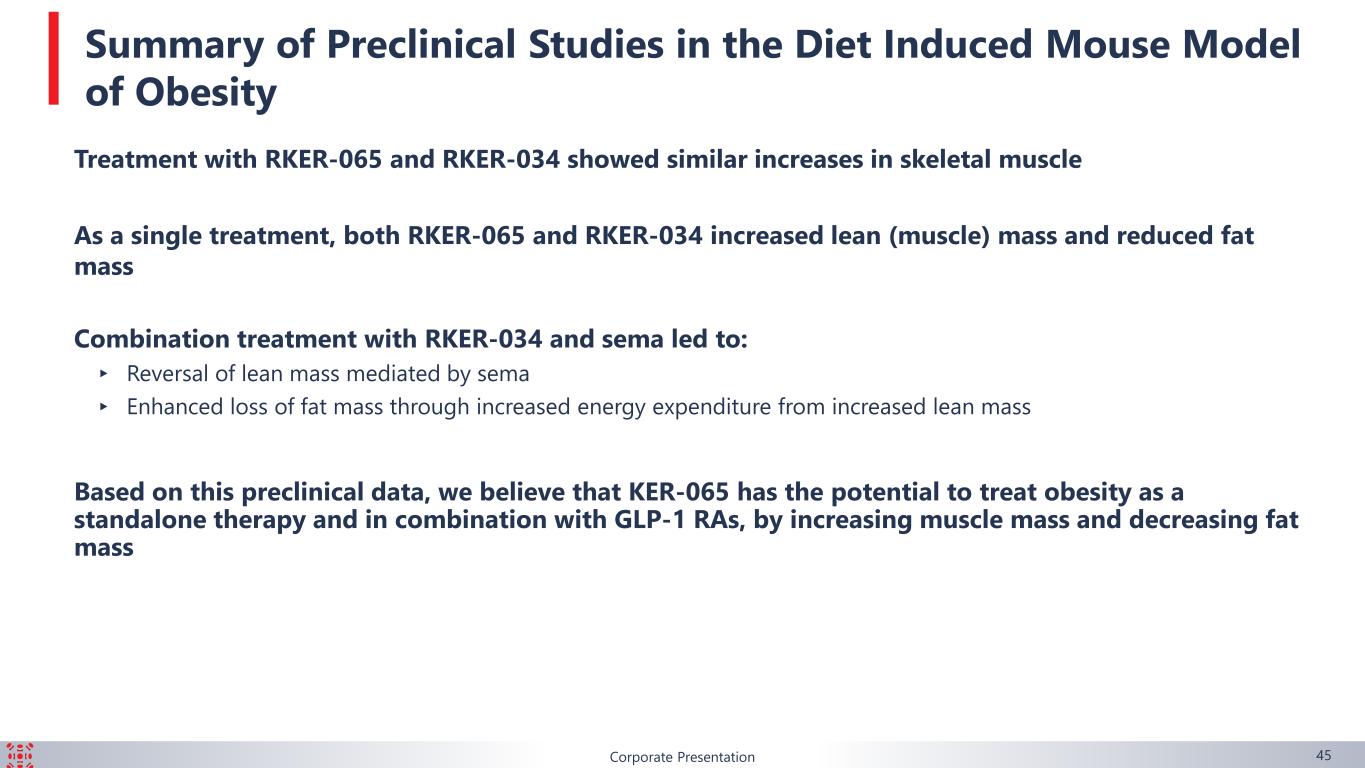
Corporate Presentation Summary of Preclinical Studies in the Diet Induced Mouse Model of Obesity Treatment with RKER-065 and RKER-034 showed similar increases in skeletal muscle As a single treatment, both RKER-065 and RKER-034 increased lean (muscle) mass and reduced fat mass Combination treatment with RKER-034 and sema led to: ▸ Reversal of lean mass mediated by sema ▸ Enhanced loss of fat mass through increased energy expenditure from increased lean mass Based on this preclinical data, we believe that KER-065 has the potential to treat obesity as a standalone therapy and in combination with GLP-1 RAs, by increasing muscle mass and decreasing fat mass 45
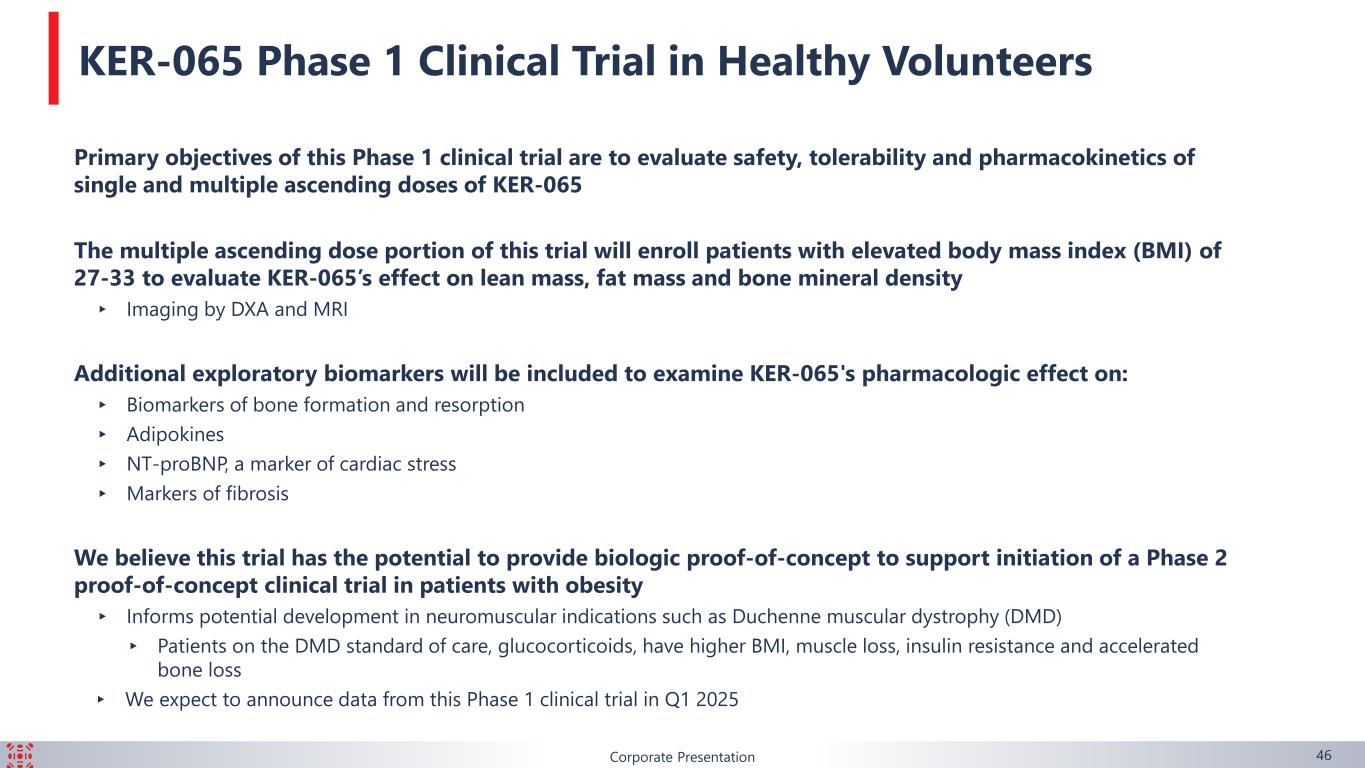
Corporate Presentation KER-065 Phase 1 Clinical Trial in Healthy Volunteers Primary objectives of this Phase 1 clinical trial are to evaluate safety, tolerability and pharmacokinetics of single and multiple ascending doses of KER-065 The multiple ascending dose portion of this trial will enroll patients with elevated body mass index (BMI) of 27-33 to evaluate KER-065’s effect on lean mass, fat mass and bone mineral density ▸ Imaging by DXA and MRI Additional exploratory biomarkers will be included to examine KER-065's pharmacologic effect on: ▸ Biomarkers of bone formation and resorption ▸ Adipokines ▸ NT-proBNP, a marker of cardiac stress ▸ Markers of fibrosis We believe this trial has the potential to provide biologic proof-of-concept to support initiation of a Phase 2 proof-of-concept clinical trial in patients with obesity ▸ Informs potential development in neuromuscular indications such as Duchenne muscular dystrophy (DMD) ▸ Patients on the DMD standard of care, glucocorticoids, have higher BMI, muscle loss, insulin resistance and accelerated bone loss ▸ We expect to announce data from this Phase 1 clinical trial in Q1 2025 46
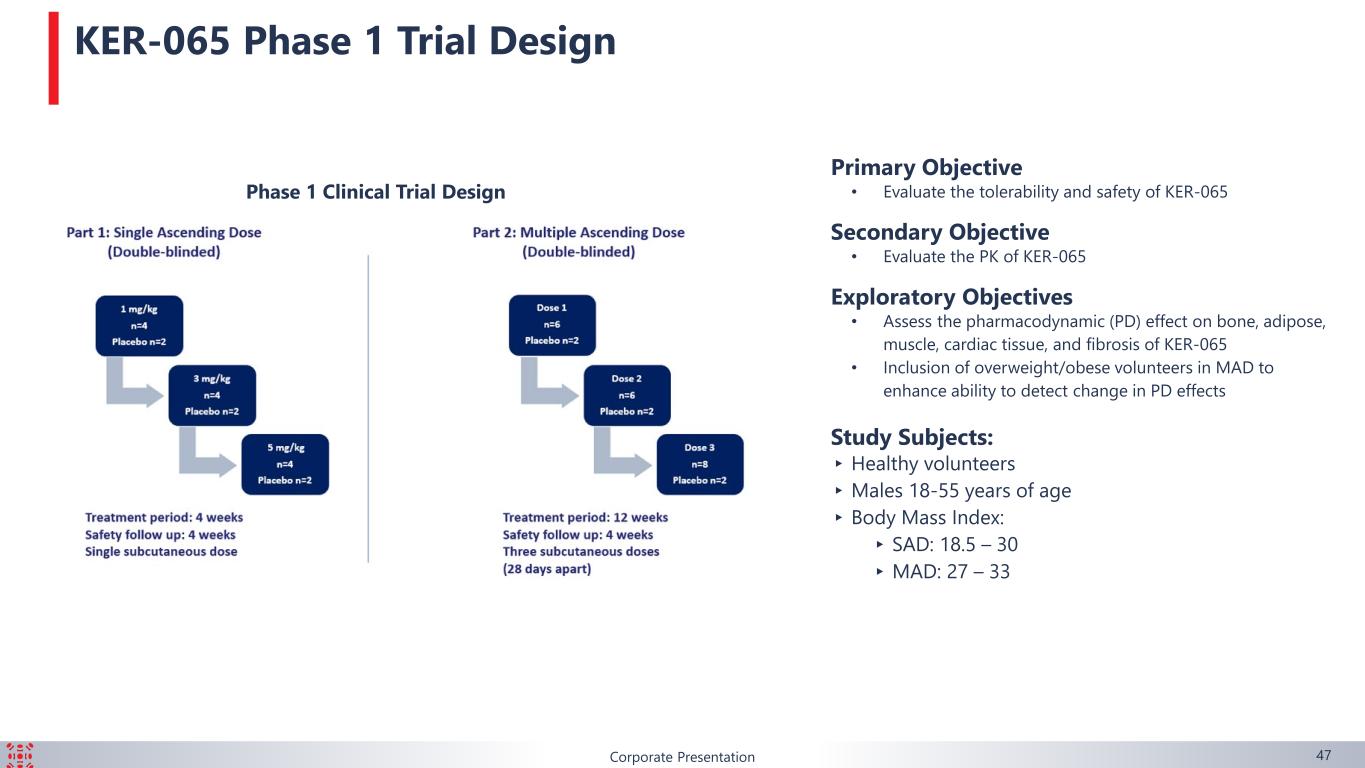
Corporate Presentation KER-065 Phase 1 Trial Design This trial has been designed to enable the evaluation of any treatment-related increases in skeletal muscle, decreases in fat and improvements in bone health. Primary Objective • Evaluate the tolerability and safety of KER-065 Secondary Objective • Evaluate the PK of KER-065 Exploratory Objectives • Assess the pharmacodynamic (PD) effect on bone, adipose, muscle, cardiac tissue, and fibrosis of KER-065 • Inclusion of overweight/obese volunteers in MAD to enhance ability to detect change in PD effects Study Subjects: ▸Healthy volunteers ▸Males 18-55 years of age ▸ Body Mass Index: ▸ SAD: 18.5 – 30 ▸MAD: 27 – 33 Phase 1 Clinical Trial Design 47
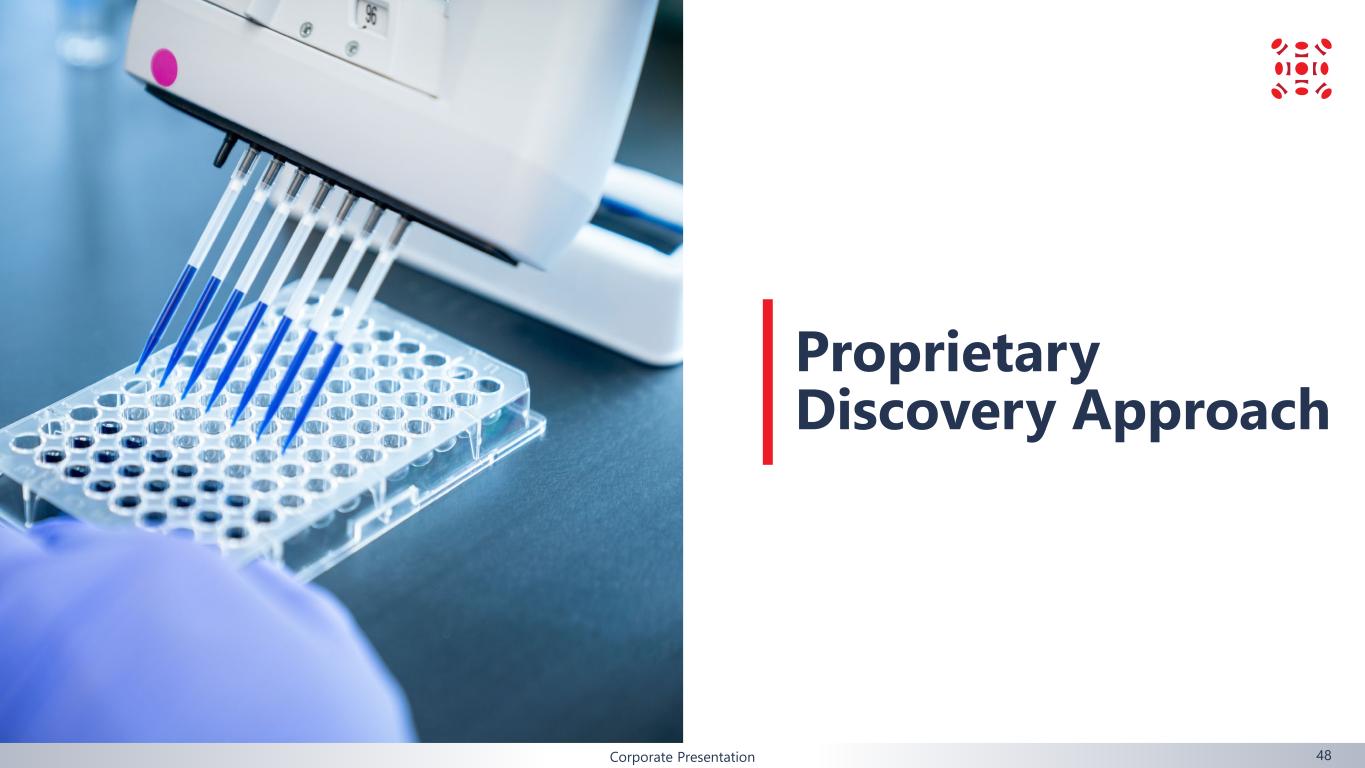
Corporate Presentation Proprietary Discovery Approach 48
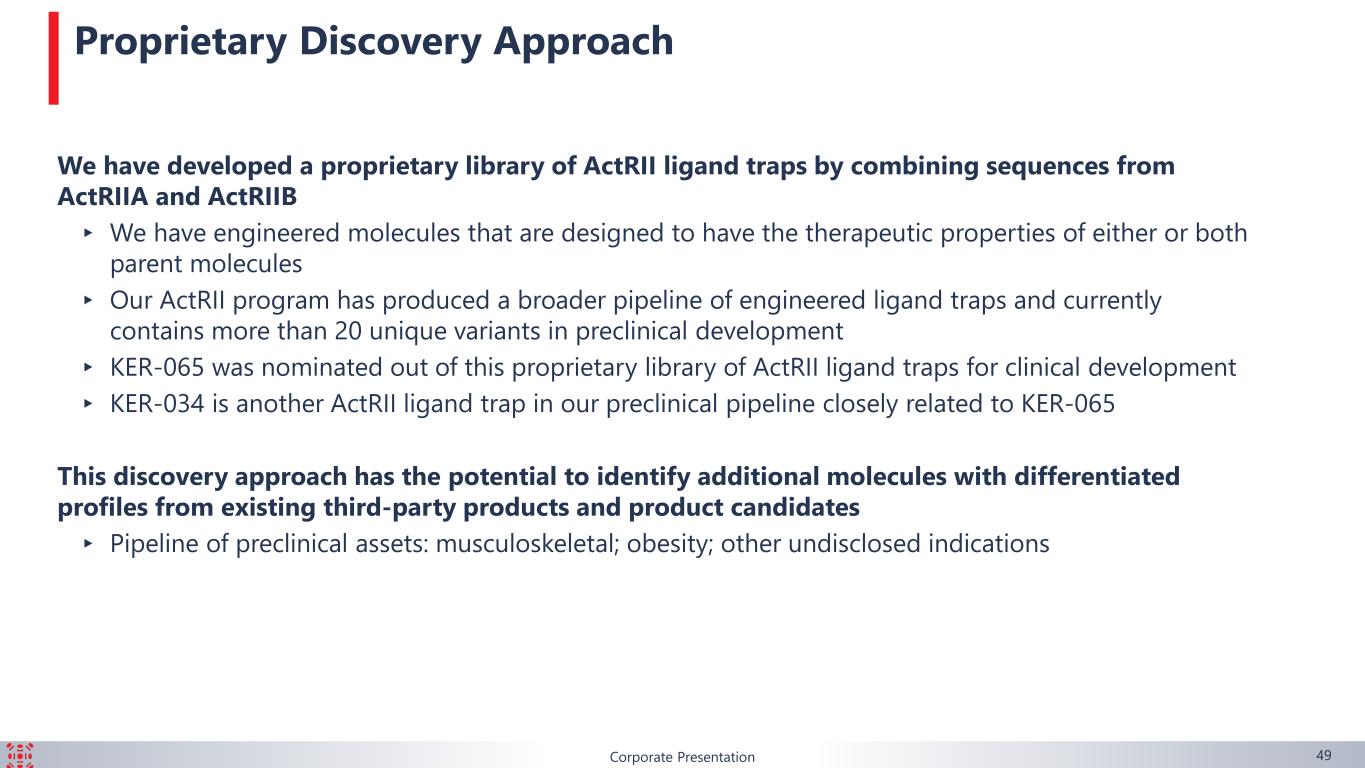
Corporate Presentation We have developed a proprietary library of ActRII ligand traps by combining sequences from ActRIIA and ActRIIB ▸ We have engineered molecules that are designed to have the therapeutic properties of either or both parent molecules ▸ Our ActRII program has produced a broader pipeline of engineered ligand traps and currently contains more than 20 unique variants in preclinical development ▸ KER-065 was nominated out of this proprietary library of ActRII ligand traps for clinical development ▸ KER-034 is another ActRII ligand trap in our preclinical pipeline closely related to KER-065 This discovery approach has the potential to identify additional molecules with differentiated profiles from existing third-party products and product candidates ▸ Pipeline of preclinical assets: musculoskeletal; obesity; other undisclosed indications Proprietary Discovery Approach 49
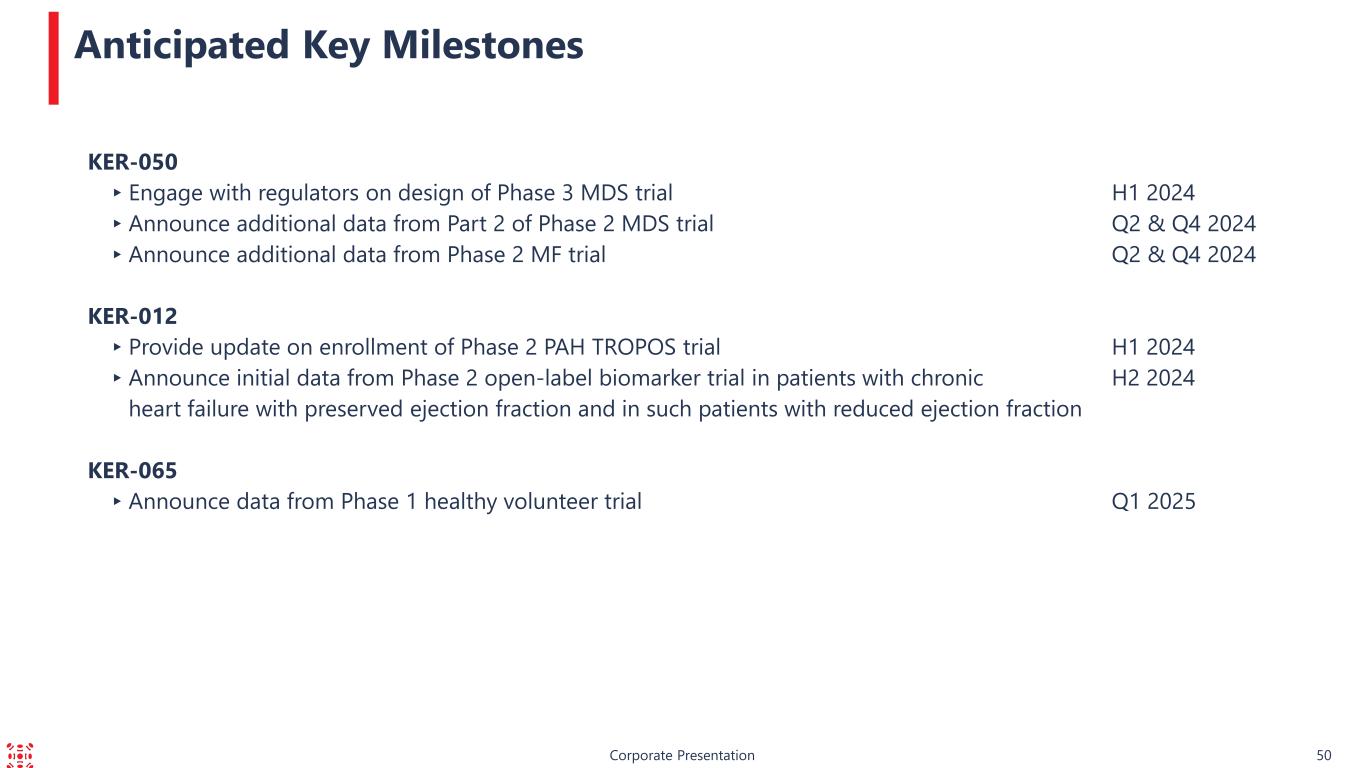
Corporate Presentation KER-050 ▸Engage with regulators on design of Phase 3 MDS trial H1 2024 ▸Announce additional data from Part 2 of Phase 2 MDS trial Q2 & Q4 2024 ▸Announce additional data from Phase 2 MF trial Q2 & Q4 2024 KER-012 ▸Provide update on enrollment of Phase 2 PAH TROPOS trial H1 2024 ▸Announce initial data from Phase 2 open-label biomarker trial in patients with chronic H2 2024 heart failure with preserved ejection fraction and in such patients with reduced ejection fraction KER-065 ▸Announce data from Phase 1 healthy volunteer trial Q1 2025 Anticipated Key Milestones 50

















































